Influential 1930s Fashion Designers
Influential 1930s Fashion Designers shaped fashion in the 1930s and reflected societal shifts, with Hollywood and economic factors shaping how people dressed. The era brought glamour and practicality together, making style accessible to all. From the silver screen to everyday life, fashion was influenced by iconic figures and innovative techniques, creating a unique blend of elegance and resourcefulness.
Fashion in the 1930s blended innovation, creativity, and resilience. As the world faced economic challenges, designers and icons reshaped style into something accessible and expressive. From Madeleine Vionnet’s fluid bias cut to Elsa Schiaparelli’s surrealist flair, fashion became a canvas for both liberation and imagination. Hollywood’s influence transformed everyday wardrobes, and even children’s fashion found a muse in Shirley Temple. This era marked a shift towards practicality without sacrificing elegance, proving that style could thrive even in adversity.
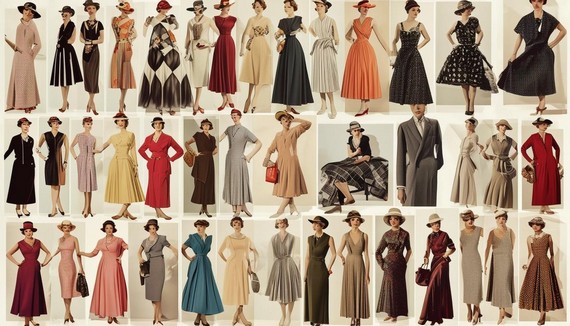
1930s fashion collage
Influence of Hollywood on 1930s Fashion
1930s Hollywood wasn’t just churning out talkies; it’s 1930s fashion designers were spinning fashion trends that could make heads turn. Joan Crawford’s organdie gown in Letty Lynton, created by MGM costume designer Gilbert Adrian, inspired Macy’s to sell nearly half a million copies. Suddenly, fashion inspiration was as close as the nearest picture palace, and every common gal could aspire to look like a star.
Greta Garbo’s minimalist and angular style, crafted by 1930s fashion designer, Gilbert Adrian, influenced women to emulate her broad-shouldered look from 1931’s Mata Hari. Clark Gable’s shirtless scene in It Happened One Night even impacted undershirt sales.
For men, knitted sweaters and blazers drew inspiration from the silver screen. American lads saw Fred Astaire and Cary Grant as style icons. The modern man’s armor became a sharp double-breasted suit, without the stiffness of Edwardian era waistcoats or spats. Plus-fours paired with flannel blazers reflected the sporty chic seen on sets.
Elsa Schiaparelli’s collaborations with surrealists established her as the go-to 1930s fashion designer for dramatic outfits. Her dresses with trompe-l’oeil effects or extravagant tailoring blurred the line between wearable art and standard attire.
Shirley Temple influenced children’s fashion, selling tons of youthful frocks inspired by her screen roles. Young girls everywhere wore frills and Peter Pan collars, hoping to capture her charm.
As the 1930s progressed, Hollywood spotlighted fashion as a measure of society’s shifting ideals. Stars became fashion leaders, making style aspirational and within reach. Films were more than entertainment; they were the runways of a new era, shaping what folks wore after the credits rolled.
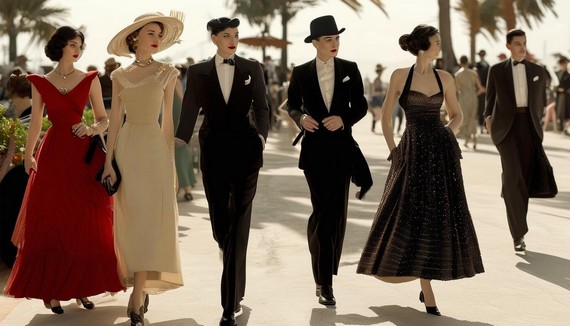
A glamorous scene depicting 1930s Hollywood-inspired fashion, with models wearing elegant gowns and suits reminiscent of movie stars
In the 1930s, Hollywood became a powerful influence on fashion, blurring the line between cinema and everyday style. Actors like Clark Gable and Greta Garbo weren’t just movie stars; they were fashion icons whose influence spread far beyond the silver screen.
Films became a showcase for the latest in haute couture, watched by millions eager to bring Hollywood glamour into their own lives. 1930s fashion designers and Costume designers like Adrian, who created Joan Crawford’s memorable Letty Lynton dress, sparked trends that quickly spread to department stores. Fashion houses rushed to meet the public’s demand for Hollywood-inspired looks, with pieces like Crawford’s puff-sleeved gowns selling by the thousands.
This influence extended to menswear as well. When Clark Gable appeared without an undershirt in 1934’s It Happened One Night, it had a noticeable impact on men’s fashion. A single cinematic moment could redefine wardrobe staples.
Beyond clothing created by 1930s fashion designers, makeup, hairstyles, and even posture were influenced by Hollywood stars. Jean Harlow’s platinum locks and Bette Davis’s bold lips became beauty ideals that women around the world sought to recreate, often with help from the growing beauty industry.
The era’s color palette was as vibrant as the stars on screen. Bright pinks and deep purples made their way to the streets, reflecting a society eager to mirror the lively energy of their Hollywood idols. This optimistic approach to fashion provided a bright spot during the decade’s economic challenges.
“Every woman could imitate and buy into, at relatively little cost, the look of her favourite stars, if only through copying their makeup and hairstyles: cinema democratized the empire of fashion by making glamour accessible.”
Cinema democratized fashion, bringing the sophistication of haute couture to the public. Hollywood’s stars became unofficial style ambassadors, transforming fashion from a topic in magazines to a living, breathing part of everyday life. As audiences left the cinema each night, they carried with them visions of glamour that seemed achievable with the right outfit or makeup.
Thanks to Hollywood, fashion became more accessible, inviting people everywhere to bring a touch of movie magic into their own lives.
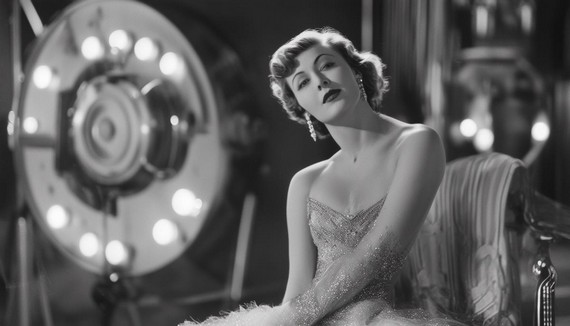
A glamorous 1930s Hollywood actress in a luxurious evening gown, posing on a movie set
1930s Fashion Designers – The Bias Cut Revolution
The 1930s marked an era where fabric suddenly had a magical allure, thanks largely to the bias cut technique championed by Madeleine Vionnet. This technique transformed fabric into a fluid entity, skimming silhouettes and marking a departure from the boxy outlines of previous decades.
Vionnet, often hailed as the “queen of the bias cut,” created garments that hugged the body, marrying elegant drapery with movement. Women of the 1930s swayed into rooms as icons of sculpted femininity. Daywear wasn’t immune to its touch either, transforming from mere functional cotton into a landscape where floral prints and geometric lines danced across sunlit pavements.
Eveningwear glowed with sophistication. Satin gowns radiated sheen as they glided under candlelit chandeliers—a nod to Grecian goddesses. Backless silhouettes rose to prominence, giving one’s spin a glamorous stage.
1930s fashion designers including Elsa Schiaparelli and Coco Chanel joined the bias-cut movement, channeling Vionnet’s vision into their own creations. The bias cut reshaped how high fashion flowed from catwalks to corner shops. Even in the throes of economic hardship, fabric danced, and women could occupy the sphere of chic sophistication.
The impact of this technique created ripples across the 1930s fashion world, influencing everything from wardrobes to how garments could flatter natural forms. Women reveled in the newfound freedom that cleverly cut fabric afforded.
Indeed, the bias cut revolution was more than just a trend—it became a lens through which elegance was redefined, offering silhouettes that mirrored the timeless nature of the spirit it enveloped.
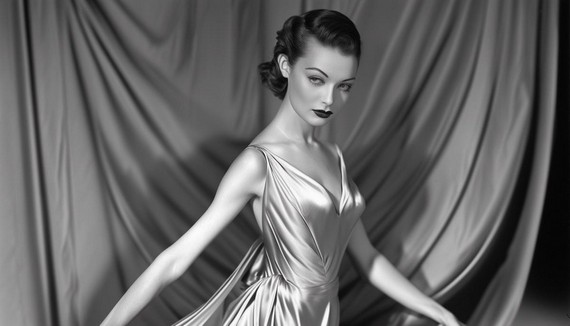
A model wearing a flowing, satin bias-cut evening gown that emphasizes the fluid draping and body-hugging silhouette characteristic of thirties fashion
Madeleine Vionnet and the Bias Cut
Madeleine Vionnet, often hailed as the “Queen of the Bias Cut,” revolutionized women’s fashion in the 1930s. Her innovative approach involved cutting fabric at a 45-degree angle against the weave. This technique gave garments a natural stretch that hugged the body, creating a fluid, elegant silhouette that moved effortlessly with a woman’s natural curves.
Vionnet’s designs floated, replacing cumbersome buttons and stiff silhouettes. Picture a satin gown that drapes softly around the form, transforming any wearer into a modern-day Venus. By the early ’30s, the fashion world embraced these body-skimming designs that felt as liberating as they looked.
Hollywood stars adored these creations. Actresses on the silver screen wore Vionnet’s flowing evening gowns, their movements unencumbered by heavy corsets. Her clothes weren’t mere garments; they were statements of freedom. A woman in a Vionnet dress was a picture of sophistication—celebrated rather than constrained.
Other 1930s fashion designers like Chanel adopted the bias cut for their own collections. The elegance spread widely, with fashionistas everywhere longing for those soft, draping lines that could elevate an ordinary night out.
Daywear also embraced the bias cut. Dresses with flaring skirts and nipped waists became popular, embodying a return to femininity without excessive trimmings. New, lightweight fabrics like rayon helped usher in a modern, streamlined look that exuded confidence and ease.
Vionnet’s clever cuts and architectural approach to fabric brought a fresh perspective to fashion. Women didn’t just wear her clothes—they experienced them. Her legacy as an architect of couture shaped a new direction for women’s fashion that continues to inspire today.
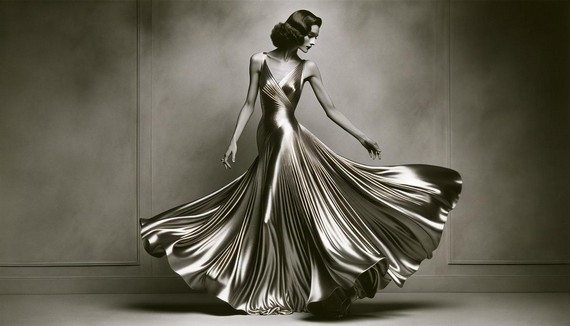
A model wearing a flowing, body-skimming bias-cut gown by Madeleine Vionnet, showcasing the elegant drape and movement of the fabric
Key Designers and Their Contributions
Elsa Schiaparelli’s creations were audacious and avant-garde, often tipping the scales of surrealism. Her partnership with artists like Salvador Dalí resulted in works such as the lobster dress, which made art wearable. Schiaparelli’s genius lay in her ability to blend the curious with the couture, bringing a sense of whimsical boldness to wardrobes everywhere.
Coco Chanel’s influence on 1930s fashion was enduring. Her designs involved the elegant pairing of practicality with sophistication. Chanel reimagined women’s fashion by prioritizing comfort while maintaining a chic silhouette. Her use of jersey fabric was revolutionary, imbuing simplicity with effortless elegance. From the little black dress to her precisely fitted suits, Chanel’s contributions laid the groundwork for modern women’s fashion.
Jeanne Lanvin was the queen of feminine elegance. Her designs were effortlessly graceful and brimming with detail. Lanvin’s forte was found in her ability to balance embellishment with fluidity, often drawing inspiration from the arts. Her use of intricate embroidery and beading set Lanvin apart, elevating each garment to a work of wearable art. The robes de style, quintessentially Lanvin, embodied a form that allowed movement while dazzling the eye.
Elsa Schiaparelli’s Surrealist Influence
Elsa Schiaparelli emerged as a force in 1930s fashion, bringing avant-garde style to the forefront. If Vionnet’s bias cut was a whisper of elegance, Schiaparelli’s designs were a playful shout, a vividly painted canvas of inventive creativity that appealed to the chic and daring.
Schiaparelli’s world turned clothes into a bold playground for the imagination. She crafted experiences, partnering with surrealist icons like Salvador Dalí and Jean Cocteau to create works that blended art and fashion. Her creations were vivid, whimsical, and sometimes intentionally perplexing.
Consider her famous lobster dress, a collaboration with Dalí. This unique piece featured a lobster boldly sprawled across its surface, embodying Schiaparelli’s signature blend of surrealism and practicality. It was designed to both clothe and provoke thought.
Surrealism was woven into every aspect of her work:
- Hats shaped like shoes
- Jackets featuring embroidered optical illusions
- Buttons resembling miniature sculptures
Schiaparelli didn’t just challenge the status quo—she reimagined it entirely.
Her use of vibrant colors like shocking pink and hyacinth blue created an emotive palette that contrasted with fashion’s then-muted tones. This bold choice declared that the world deserved a kaleidoscope, not just a monochrome.
Despite the whimsy, Schiaparelli maintained a deep respect for the craftsmanship of haute couture. Her clothes were precisely constructed, with attention to fine details and embroidery.
In an era tending towards conservatism, Elsa Schiaparelli gave fashion a new language. She showed that clothes could be more than fabric—they could be statements and dreams realized in texture and color. Her legacy lives on in the playful spark she ignited, encouraging us to see fashion as a form of self-expression and a celebration of the fantastical.
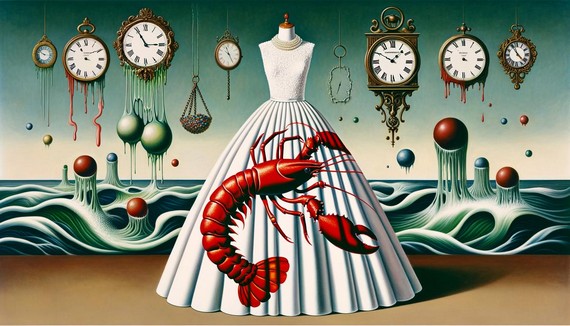
A model wearing Elsa Schiaparelli’s famous lobster dress, a white evening gown with a large red lobster print
Together, in the avant garde of 1930s fashion designers, Schiaparelli, Chanel, and Lanvin orchestrated a fashion symphony that played against the backdrop of a world in flux, demonstrating how apparel could both honor personal style and defy societal constraints. Their designs challenged conventions and beckoned a more inclusive approach towards individuality in fashion.
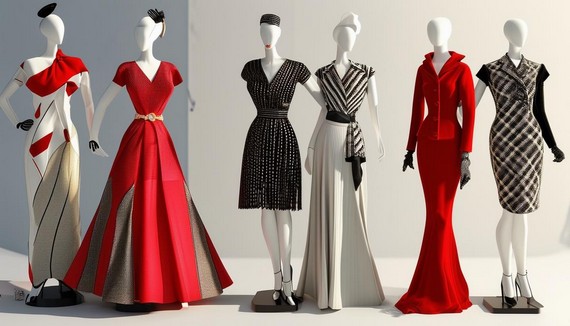
A fashion display showcasing iconic designs from Elsa Schiaparelli, Coco Chanel, and Jeanne Lanvin, highlighting their unique contributions to 1930s fashion
1930s Fashion Designers – Economic Impact on Fashion
The Great Depression cast a long shadow over fashion in the 1930s. With tightened purse strings, the industry underwent a shift that migrated from haute couture to high street. Fashion houses and 1930s Fashion Designers adapted with ingenuity and pragmatism, turning necessity into the mother of invention.
Affordability became a badge of smart styling. 1930s Fashion Designerstraded lavish embellishments for minimalist elegance, ensuring that chic wasn’t sacrificed for economics. Suits, dresses, and accessories were made to last longer yet wear with grace.
Fabrics found new lifelines. Crepe, rayon, and jersey were celebrated for their cost-effective durability and fine drape. 1930s fashion designers could evoke the sumptuousness of silk with rayon, making previously unattainable luxuries achievable. Rayon’s rise in popularity saw it gracing everything from day dresses to fashion-forward frocks.
The bias cut technique was used not merely for aesthetics but for material efficiency as well. More could be done with less—and every artful drape became a testament to mindful resourcefulness. This drift towards savvy design repurposed even simpler garments like flour sack dresses into style statements.
Department stores and home sewers adopted accessible patterns and styles, making fashion more egalitarian. DIY creation bloomed out of necessity and creativity. Pattern companies sold designs inspired by high fashion at affordable prices, allowing women to create garments customized in spirit and fit.
The Depression may have challenged the spirit of style, but it prompted a vibrant resilience. Its legacy was a testament to adaptability, proving that even when purse strings are tight, style need not be. 1930s Fashion Designers and fashion in the 1930s demonstrated that elegance needs no ostentation, only a sprinkle of imagination and the courage to defy economic constraints.
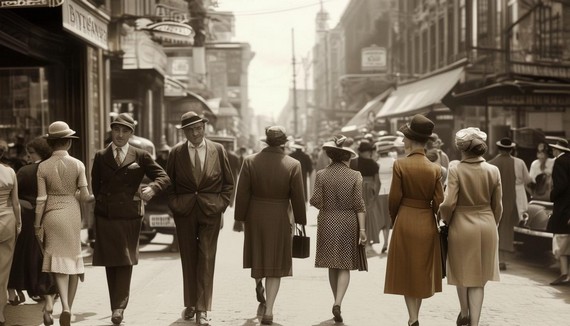
A street scene showing people wearing practical yet stylish 1930s clothing, emphasizing the economic impact on fashion during the Great Depression
The 1930s saw fashion evolve in response to the economic realities of the Great Depression. As glamour shone on movie screens, the world off-screen adapted to tighter budgets, leading to more accessible and democratic fashion trends.
The stock market crash of 1929 put an end to the opulence of the previous decade. The Great Depression sparked creativity in frugality, with consumers seeking garments that offered both style and value. Fashion became less about fleeting indulgence and more about functional, durable pieces that could withstand daily wear.
1930s Fashion Designers responded by creating elegant yet accessible styles. Clean lines and purposeful silhouettes replaced the frills of the 1920s. Versatile fabrics like rayon, which mimicked more expensive materials at a lower cost, became popular. This allowed for everyday elegance without breaking the bank.
Couture houses adapted to economic pressures by selling toiles—simple muslin patterns of their high-end designs. This clever move allowed consumers to experience designer luxury at a fraction of the cost, making French fashion more accessible to Americans struggling through hard times.
Production techniques also shifted. As high duties on imported luxury fashion strained international shipments, 1930s fashion designers in America and elsewhere began creating home-grown styles that echoed haute couture. Affordable materials and trendy patterns allowed everyday wardrobes to reflect couture influences in cost-effective ways.
The iconic flour sack dress exemplified this era’s resourcefulness. Manufacturers printed patterns on flour sacks, recognizing that homemakers were repurposing them for clothing. This ingenious upcycling became a symbol of fashion’s resilience in the face of hardship.
By the end of the decade, 1930s fashion had transformed. It was no longer exclusive to the elite but stood as an achievable indulgence for many. The industry had learned to navigate adversity, creating styles that balanced necessity with aspiration—a testament to the enduring spirit of fashion even in challenging times.
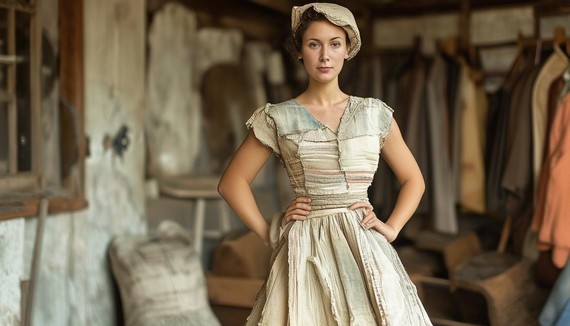
A woman wearing a stylish dress made from repurposed flour sacks, showcasing the resourcefulness of 1930s fashion during the Great Depression
Shirly Temple and Children’s Fashion Influences
Children’s clothing in the 1930s offered its own notable chapter in 1930s fashion design, warmly influenced by the pint-sized celebrity, Shirley Temple. As she twirled across the silver screen, little girls across the globe yearned to mirror her captivating style, initiating a trend in both fabrics and the simple joys the garments brought.
Fabric choices were about practicality as well as preference. Flour sack dresses emerged as a resourceful response to financial stringency, with mothers transforming cotton sacks into charming frocks. Mills soon began printing these sacks with cheerful patterns and hues, brightening up wardrobes with recycled ingenuity.
Shirley Temple’s influence wove itself into girls’ fashion:
- Fluffy frocks with layers of petticoats
- Peter Pan collars
- Puffed sleeves and embroidered accents
- High-waisted dresses with piped detailing
Cotton and muslin were the favored materials, durable yet soft against tender skin. Dresses with a hint of frill at the hems bounced along with youthful exuberance, all while aligning with the prevailing economics of the decade.
Sailor suits added a charming nautical theme for both girls and boys. For boys, the pragmatic shift saw them donning durable corduroy shorts with knitted vests, matching their dads in downscaled models of adult fashion.
Retailers like Sears crafted Shirley Temple-inspired dress lines that were very popular. Tailoring the on-screen magic into dresses, coats, and even snowsuits gave families a slice of cinema magic, all customized for playgrounds and birthday parties.
The era’s economic frugality fostered a bloom in fashion that was both accessible and imaginative. Parents found joy in crafting or acquiring garments that shimmered with their children’s boundless energy and captured the essence of youthful dreams. 1930s children’s fashion thrived on its clever blend of necessity and nostalgia, all vying to see the world through the zealous cheer of a child star’s eyes.
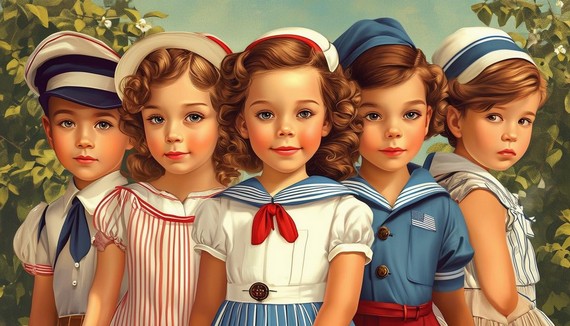
A group of children wearing typical clothing, including Shirley Temple-inspired dresses for girls and sailor suits for boys
The 1930s demonstrated that fashion could be both a form of personal expression and a response to broader societal changes. By blending glamour with practicality, 1930s Fashion Designers of the era left a lasting impact on how we view style, proving that elegance can thrive even in challenging times.
In the 1930s, Shirley Temple emerged as a cultural icon whose influence extended far beyond the silver screen and into children’s fashion. Her signature style—short, puffed-sleeve dresses adorned with tulle or lace, paired with patent leather Mary Jane shoes and ankle socks—quickly became the quintessential “little girl” look of the era.
Shirley Temple’s fashion impact was particularly significant given the context of Depression-era America. Her charming outfits, affordably replicated by retailers, provided an attainable piece of glamour for families struggling through economic hardship. Dressing daughters in Shirley Temple-inspired frocks offered a moment of joy and escapism from the challenges of the time.
This wasn’t just a passing trend; it marked a shift in children’s fashion norms. Temple’s bold style choices, featuring vibrant fabrics and cheerful designs, challenged the notion that children’s clothing should be purely practical. Her popularity ushered in an era where children’s fashion was considered an area worthy of creativity and attention.
Shirley Temple’s influence blurred the line between childlike innocence and celebrity allure, empowering young girls to express their individuality through clothing. Many eagerly adopted her famous ringlet hairstyle, participating in a celebration of personal style inspired by Temple’s charm.
In children’s 1930s fashion, Shirley Temple did more than popularize puffy sleeves and adorable frocks; she inspired a culture that valued imagination and style even in challenging times. Her legacy reminds us of fashion’s power to shape not just appearances, but also to offer a shared story of hope and creativity for an entire generation.
Shirley Temple’s Fashion Impact:
- Popularized puffed-sleeve dresses with tulle and lace
- Inspired affordable replicas for mass market
- Challenged practical norms in children’s clothing
- Empowered girls to express individuality
- Created a cultural phenomenon with her ringlet hairstyle
Young Shirley Temple in her iconic puffed-sleeve dress, Mary Jane shoes, and ringlet curls, smiling at the camera
The 1930s taught us that fashion is not just about clothing; it’s about resilience, creativity, and expression. Whether through the liberating cuts of Vionnet or the playful designs of Schiaparelli, this decade left an indelible mark on how we view style as a reflection of both individual and collective spirit.
References:
- Blackman C. 100 Years of Fashion. Laurence King Publishing; 2012.
- Laver J. Costume and Fashion: A Concise History. Thames & Hudson; 2002.
- McDowell C. The Man of Fashion: Peacock Males and Perfect Gentlemen. Thames & Hudson; 1997.
- Koda H. Haute Couture. Metropolitan Museum of Art; 1995.
1930s Fashion Designers – Coco Chanel 1930s Fashion
Coco Chanel’s influence on fashion is a testament to her ability to blend elegance with practicality. Her work in the 1930s, characterised by innovative use of materials and design techniques, marked a significant shift in women’s 1930s fashion. By reimagining traditional styles and introducing new concepts, Chanel offered a fresh perspective that resonated with the modern woman.
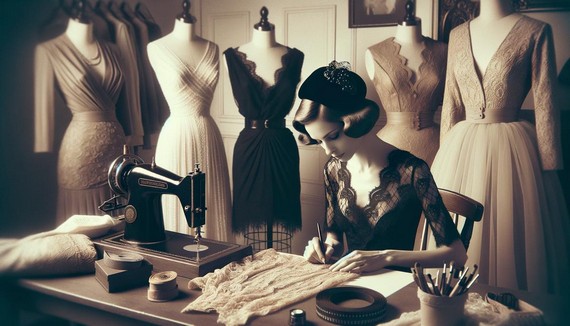
coco chanel 1930s fashion
Coco Chanel’s Romantic Period
Lace and tulle defined Coco Chanel’s 1930s “romantic” period, bringing a fresh take on elegance. Chanel innovated by deconstructing conventional gowns to showcase their craftsmanship. She used lace as her canvas, employing vertical overstitching to fix delicate layers, blending aesthetics with function.
Her creations became a form of poetry, using stitches instead of words. Chanel’s dresses married the past’s romance with modern design practicality. The lace wasn’t merely decorative—it was structural, almost like a skeleton supporting the garment. With a delicate touch and forward-thinking approach, Chanel ensured that fashion wasn’t just about appearances.
Her work represented a fusion of art and intention woven through every inch of fabric.
In Chanel’s hands, lace and tulle weren’t just materials—they were muses. The result was a chic rebellion against the clutter of previous decades, embracing what’s authentic and meaningful in fashion.
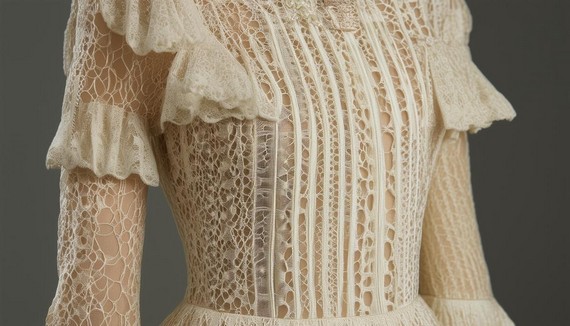
A delicate 1930s Chanel lace dress showcasing vertical overstitching and intricate craftsmanship
Innovations in Fabric and Design
Coco Chanel’s genius lay in marrying elegance with functionality, exemplified by her pioneering use of jersey. Once relegated to men’s undergarments, jersey became a symbol of liberation in Chanel’s haute couture. This textile choice was a deliberate move towards modernity, allowing her designs to drape gracefully while offering comfort and practicality.
Chanel’s innovative techniques, like vertical overstitching, brought structure to fluid fabrics. This approach unified aesthetics and utility, transforming clothing into empowering pieces where every seam celebrated unrestricted movement.
Whether crafting a little black dress or wide-leg trousers inspired by menswear, Chanel’s choice of fabric and construction techniques were always purposeful—designed to meet the needs of active women. Her collections reimagined traditional silhouettes with luxurious yet user-friendly materials, creating garments that aligned with modern living while offering both adaptability and sophistication.
Every fold of fabric in a Chanel piece was precisely placed and imbued with purpose. Her clothes moved and lived with the wearers, becoming partners in their daily routines. Chanel wasn’t just dressing women to be seen; she was designing for them to feel comfortable and empowered, with each innovation reflecting the perfect balance of form and function.
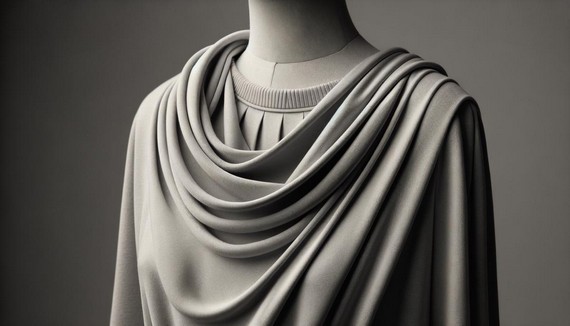
A close-up of Chanel’s innovative use of jersey fabric in a 1930s haute couture design
1930s Fashion Designers – The Little Black Dress
In the 1930s, amid the Great Depression, Gabrielle “Coco” Chanel created the iconic little black dress (LBD). This 1930s fashion staple wasn’t just a response to economic hardship; it embodied Chanel’s style philosophy of simplicity and sophistication.
The LBD emerged as an essential garment for all women—a canvas for personal expression that could transition seamlessly from day to night with a change of accessories. Its clean lines and flattering cut brought focus back to the wearer, allowing her personality to shine.
- Stood for liberation and resilience
- Empowered women during challenging times
- Invited creativity in styling
- Paired well with pearls or simple pumps
- Gave women agency in personal presentation
By combining functionality and aesthetics, the little black dress adapted to women’s multifaceted roles. It became an ally in everyday life, subtle yet memorable—a testament to Chanel’s visionary approach. The LBD’s enduring appeal proves that true elegance often speaks through simplicity and grace, leaving a lasting impression that outshines complexity.
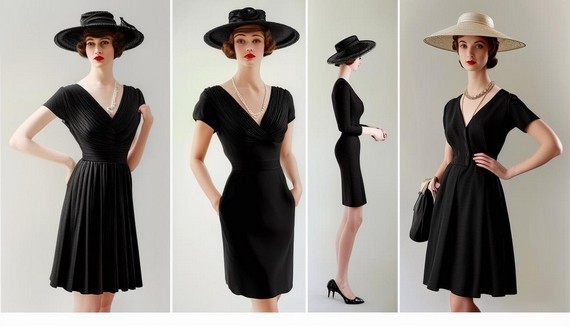
A Chanel Little Black Dress from the 1930s shown in different styling scenarios, from day to night
Coco Chanel’s Influence on Women’s Fashion
Chanel’s impact on women’s fashion extended beyond revolutionizing wardrobes; as one of the most influential 1930s fashion designers she paved the way for a new era of liberation in dress. In the early 20th century, Coco Chanel redefined femininity in fashion, freeing women from restrictive garments.
Central to Coco Chanel’s influence was her iconic suit. The collarless jacket paired with a streamlined skirt, made from casual fabrics like tweed, embodied a blend of masculine cuts and feminine elegance. This design wasn’t just clothing; it represented empowerment, allowing women to move confidently in both public and professional spheres.
In evening wear, Coco Chanel challenged conventions with gowns that exemplified understated luxury. Her creations relied on simple silhouettes and quality materials to express elegance, moving away from restrictive boning and elaborate ornamentation. Chanel’s use of fabrics like lace and tulle offered a nod to romanticism while remaining firmly modern.
Chanel’s philosophy centered on the idea that fashion should empower, not dictate. She promoted aesthetics that balanced practicality with beauty, ensuring her designs were relatable and suited to varied lifestyles. Through her work, Chanel provided women with the tools to break down social and cultural barriers, promoting a vision where clothes were extensions of a woman’s liberated spirit.
Her lasting influence is visible not just in specific designs but in the spirit of sartorial freedom she instilled in each wearer. Chanel’s legacy continues to resonate in modern fashion, reminding us of the enduring significance of clothing designed to empower.

A woman wearing a classic Chanel suit, exuding confidence in a 1950s professional setting
Chanel’s Jewellery and Accessories
Chanel’s approach to jewellery and accessories marked another fashion revolution. Her introduction of costume jewellery in the early 20th century challenged the notion that adornments had to be precious to be stylish. These bold pieces were integral to Chanel’s fashion philosophy, infusing accessories with the same elegance and functionality as her garments.
Coco Chanel democratized adornment by crafting pieces that stood as art in their own right, blending real and faux elements to create captivating designs. Her collaboration with Italian jeweller Duke Fulco de Verdura resulted in iconic pieces like the Maltese Cross cuffs, which celebrated the art of contrast.
These accessories complemented Chanel’s clothing designs in both harmonious and bold ways. Multi-strand faux pearl necklaces, for instance, nodded to timeless elegance while breaking free from tradition. Coco Chanel’s jewellery enabled women to mix, match, and transform their outfits easily and affordably.
“A woman should mix fake and real. The point of jewelry isn’t to make a woman look rich but to adorn her; not the same thing.” – Coco Chanel
By embracing costume jewellery, Coco Chanel invited fashion enthusiasts to explore accessories as a medium of self-expression, independent of cost or rarity. Her accessories were designed to interact with rather than overshadow her clothing, ensuring every ensemble told a cohesive story.
Chanel’s bold vision in jewellery and accessories continues to inspire, encouraging us to embrace a fashion ethos where elegance is inclusive, playful, and personal. In her world, jewellery was never an afterthought but an essential part of the sartorial narrative, as fundamental as the garment itself.
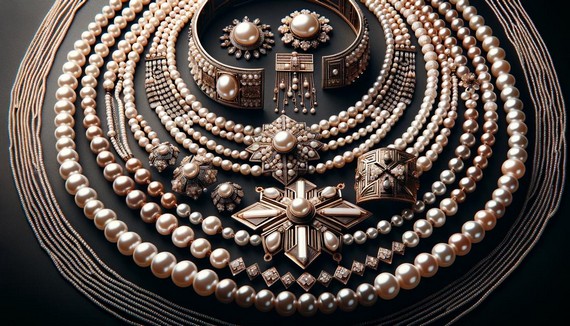
An array of Chanel’s costume jewellery from the 1930s, including faux pearl necklaces and the Maltese Cross cuffs
Chanel’s legacy as one of the most influential 1930s Fashion Designers is a celebration of fashion as an expression of strength and individuality. Her designs continue to inspire, reminding us that true elegance lies in simplicity and functionality. Through her vision, Coco Chanel has left an indelible mark on the fabric of fashion history.
References:
- Vogue. The Story of Coco Chanel: How the Fashion Icon Shaped 20th Century Style. Condé Nast; 2021.
- The Metropolitan Museum of Art. Gabrielle “Coco” Chanel (1883–1971) and the House of Chanel. Heilbrunn Timeline of Art History; 2004.
- Chanel Official Website. Inside Chanel: The History of the Iconic Fashion House. 2023.
1930s Fashion Designers – Gilbert Adrian – Fashion Impact
Gilbert Adrian’s contributions to fashion and cinema have left an indelible mark, blending the elegance of high fashion with the allure of Hollywood’s golden era. His ability to merge style with storytelling transformed how audiences engaged with film and fashion, offering a glimpse into a world where glamour was both accessible and aspirational.
Gilbert Adrian’s Hollywood Influence
Gilbert Adrian revolutionized film wardrobe by weaving the enchantment of couture directly into Hollywood’s golden days. At MGM, he outfitted stars like Greta Garbo and Joan Crawford in high fashion that influenced trends both on and off screen. His gowns for films like “Letty Lynton” turned actresses into icons, reshaping how moviegoers perceived Hollywood stars.
Adrian’s designs were stylish yet wearable, bringing onscreen glamour into everyday life. The broad-shouldered suits he crafted for Joan Crawford not only became her signature look but also set the fashion agenda for women everywhere. His ruby slippers for Dorothy in “The Wizard of Oz” exemplified his ability to create memorable, iconic pieces.
Even during World War II fabric rationing, Gilbert Adrian delivered excellence without compromising on glamour. He adapted to wartime constraints, proving that style could thrive under limitation. His floor-length dresses and shoulder pads served as an upbeat response to austerity, offering inspiration to audiences during challenging times.
Opening his own fashion house marked a new chapter, making Hollywood allure accessible to everyday people while maintaining his opulent style. Whether dressing stars or designing for the public, Gilbert Adrian’s capacity to imbue garments with star power meant that even day dresses conveyed a touch of Tinseltown sparkle.
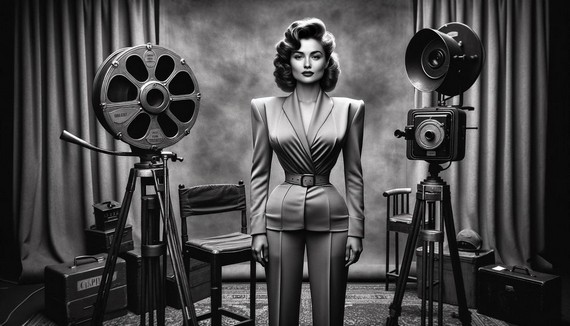
Joan Crawford wearing an Adrian-designed suit with broad shoulders, epitomising 1940s Hollywood glamour
Gilbert Adrian’s Adaptation to Wartime Fashion
During World War II, Adrian’s creativity shone as he navigated the constraints of fabric rationing. He skillfully adapted to the General Limitation Order L-85, turning necessity into an opportunity for innovation. By reducing excess material—eliminating cuffs and trimming down lapels—he focused on essentials, crafting elegant silhouettes with less fabric.
Adrian’s wartime designs struck a balance between thrift and theatricality. He offered women chic garments that felt like a quiet rebellion against austerity. His inventive use of cuts and clever fabric choices infused everyday apparel with glamour, making fashion a form of resilience.
“The most vital thing for fashion to do today is to fit itself into the pattern of the Government. If fashion can’t do this, it has no place. I don’t think that women want to be dreary nor that the Government wishes fashions to be uninspiring or dull.”
Drawing inspiration from art and nature, Gilbert Adrian created prints that added vibrancy to wartime fashion. His designs, from playful barnyard motifs to patriotic themes, resonated with hidden vivacity. He retained a sense of optimism in his work, aware of fashion’s power to uplift spirits during trying times.
Adrian exemplified that style could excel against the odds, becoming both a comfort and a symbol of endurance. His wartime adaptations echoed his belief that fashion should empower, inspire, and captivate, regardless of circumstances.
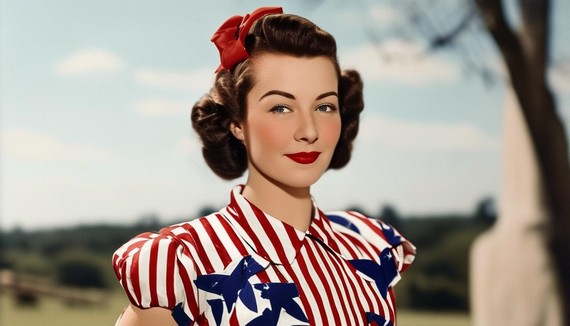
A 1940s woman wearing an Adrian-designed dress with patriotic print, showcasing wartime fashion innovation
Signature Styles and Innovations
Gilbert Adrian’s design language spoke volumes through signature styles and innovations. His bold, avant-garde fashion pushed beyond established sartorial boundaries. The exaggerated shoulders he pioneered for Joan Crawford became an emblem of his work, redefining women’s silhouettes and suggesting strength and confidence.
His mastery of bias-cut gowns celebrated the female form with elegance and fluidity. This technique revolutionized evening wear, bringing a touch of decadence to everyday fashion. Adrian’s integration of art movements into fashion made everything from cubism to surrealism wearable. The “Shades of Picasso” gown from his “Modern Museum” collection fused abstract art with apparel, creating pieces that were as much statements as they were garments.
- The Dalí dress, featuring a print designed by Salvador Dalí
- The Roan Stallion dress, showcasing Adrian’s passion for nature
- “The Egg and I” dinner gown with playful barnyard motifs
These innovations became Gilbert Adrian’s gift to fashion, influencing generations of designers. By embracing the avant-garde, he expanded the possibilities of what fashion could achieve, proving that luxury and accessibility could coexist. Adrian’s imaginative spirit and technical brilliance set him apart as a trendsetter who forever altered the fashion landscape.
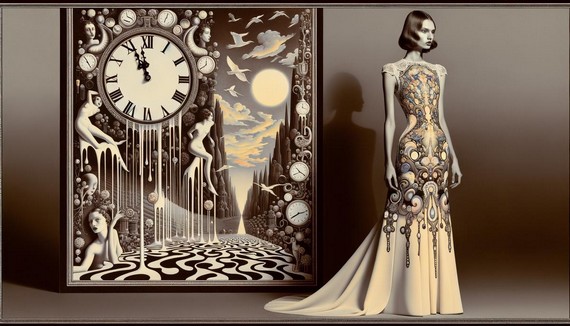
A model wearing Adrian’s famous Dalí dress, featuring surrealist motifs on a sleek silhouette
Gilbert Adrian’s Legacy and Influence
Adrian’s legacy in fashion retains an undeniable appeal, testament to his artistry and innovative foresight. After transforming Hollywood costume design, he successfully translated his cinematic flair into ready-to-wear fashion, laying the groundwork for accessible glamour that retained a touch of Hollywood mystique.
Establishing his own fashion house in Beverly Hills, Gilbert Adrian offered more than just clothing; he presented a lifestyle of sophistication. His collections, from “Adrian Custom” to “Adrian Original,” maintained the genius that characterized his cinematic creations. Despite wartime constraints, his emphasis on form and function invigorated the fashion industry.
Adrian’s influence continues to inspire contemporary designers. His work set a benchmark for blending art and fashion, paving the way for cross-disciplinary creativity. His approach to fashion as a communicative medium influenced how stories and personas are conveyed through garments, turning runway walks into dialogues.
Today, Gilbert Adrian’s bold choices resonate in collections that embrace individuality and strength. His creations have inspired designers to look beyond fabric, imbuing fashion with stories and emotions. This timeless influence celebrates elegance and offers a masterclass in how personal vision can redefine an industry.
Adrian’s legacy isn’t just about the clothes he left behind; it’s about the relentless creativity that continues to inspire generations. In fashion’s evolving dynamics, Adrian’s name remains a constant, reminding us that true style is rooted in courage and imagination.
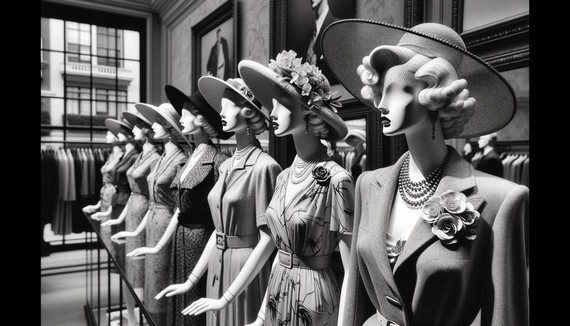
A display of Adrian’s ready-to-wear collection in his Beverly Hills fashion house, showcasing his transition from Hollywood to high street
Gilbert Adrian’s legacy demonstrates that true style transcends time. His work continues to inspire, reminding us that fashion is about telling stories and evoking emotions. In celebrating his influence, we acknowledge the enduring power of creativity by 1930s Fashion Designers in shaping fashion.
References:
-
- Cole DJ, Deihl N. The History of Modern Fashion: From 1850. Laurence King Publishing; 2015.
- Women’s Wear Daily. Vital for Fashion to Fit into Today’s Program. April 28, 1942:3.
1930s Fashion Designers – Norman Hartnell Royal Designs
Norman Hartnell‘s designs blend tradition with modernity, crafting garments that resonate with history while capturing the spirit of their time. His work with the British royal family showcases a journey through fashion, marked by creativity and attention to detail. Each piece reflects both the wearer’s identity and the cultural context of the era.
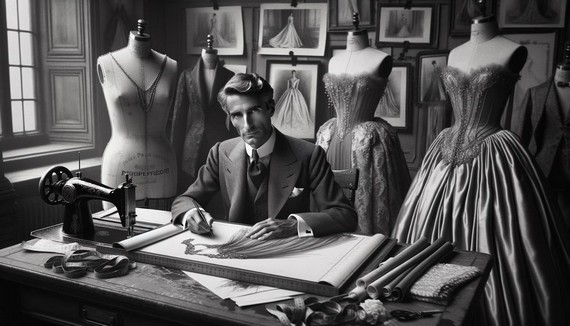
Hartnell royal fashion legacy
Norman Hartnell’s Early Royal Commissions
Norman Hartnell’s journey from budding designer to royal fashion favorite began with a commission for Lady Alice Montagu Douglas Scott’s wedding gown in 1935. Lady Alice, fiancée of Prince Henry, Duke of Gloucester, chose a blush pink dress instead of traditional white. Hartnell created an elegant gown with full-length sleeves, an Edwardian high neckline, and a stunning train.
This project introduced Hartnell to Princess Elizabeth (future Queen Elizabeth II) and Princess Margaret during bridesmaid fittings. This acquaintance with the royal family set the stage for Hartnell’s influential career in royal fashion.
In 1947, Princess Elizabeth needed a gown for her wedding to Prince Philip. Despite post-war fabric rationing, Hartnell created a masterpiece. The gown featured:
- A sweetheart neckline
- Long sleeves
- A fitted waist
- Over 10,000 seed pearls and crystals
Inspired by Botticelli’s Primavera, the dress symbolized celebration and rebirth.
Queen Elizabeth II’s 1953 coronation gown showcased Hartnell’s creativity and use of symbolism. He incorporated floral emblems from Commonwealth nations, each intricately embroidered and jewel-adorned. The challenge of making Wales’ humble leek look regal was solved with a touch of diamonds.
For Princess Margaret’s 1960 wedding, Hartnell designed a gown praised for its simplicity and elegance. It complemented Margaret’s Poltimore tiara and suited television’s first broadcast of a royal wedding.
Norman Hartnell’s ability to transform the ordinary into the extraordinary left an indelible mark on royal fashion. His designs, layered with history and a touch of drama, painted a picture of timeless elegance for generations.
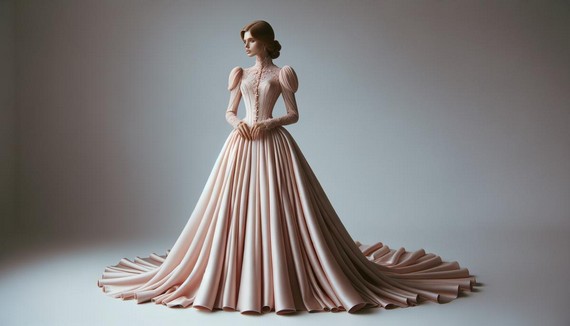
Lady Alice Montagu Douglas Scott wearing her blush pink Norman Hartnell wedding gown with Edwardian high neckline and long train
The Iconic 1947 Royal Wedding
The 1947 royal wedding of Princess Elizabeth to the Duke of Edinburgh was a moment of optimism and glamour, masterfully conveyed through Norman Hartnell’s designs. Hartnell created a wedding dress that adorned a future queen and resonated with a nation eager for hope after World War II.
Crafting this gown during post-war fabric rationing was challenging, but Hartnell’s imagination flourished. The dress featured:
- A sweetheart neckline
- Long sleeves
- A fitted waist
This created a silhouette of stately grace without extravagance.
Inspired by Botticelli’s “Primavera,” the gown was adorned with embroidered garlands and over 10,000 seed pearls and crystals, symbolizing renewal and post-war prosperity. The bridesmaids’ dresses, including Princess Margaret’s, complemented the bridal gown with naturalistic floral motifs.
Hartnell’s creation encapsulated regality, British craftsmanship, and a shared spirit of renewal. In a time of austerity, he delivered a royal ensemble that met the occasion’s demands and assured his place as a designer who could weave magic with fabric and pearls.
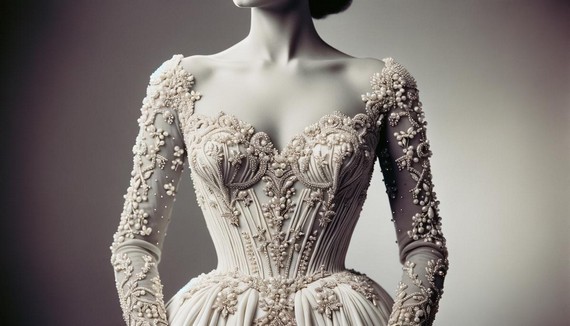
Princess Elizabeth in her Norman Hartnell-designed wedding gown, featuring a sweetheart neckline, long sleeves, and intricate pearl and crystal embroidery
Norman Hartnell – Designing for a Coronation
The 1953 coronation of Queen Elizabeth II presented Norman Hartnell with the challenge of weaving Britain’s traditions and Commonwealth unity into one majestic gown. His approach balanced history and modernity, with each stitch carrying the weight of centuries.
Hartnell envisioned a dress as a canvas for floral emblems representing the Commonwealth. This included:
- England’s Tudor Rose
- Scotland’s Thistle
- Wales’ Leek
- Symbols from other Commonwealth nations
Each emblem was carefully researched to ensure historical accuracy and significance.
The gown’s luxurious white satin base provided an opulent foundation for the ornamental embroidery, where pearls and crystals intertwined with silk threads. Hartnell balanced splendor with form, mirroring the wedding gown’s elegance but with elevated regality for the historic occasion.
Designing for a coronation required navigating courtly traditions and symbolism. Hartnell’s sketches evolved under Queen Elizabeth’s careful consideration, striking a balance between regal stateliness and modern chic.
The coronation gown encapsulated an era, walking the line between history and modernity with grace. It clothed a queen and symbolized the strength and unity of the Commonwealth, leaving an enduring legacy in royal fashion.
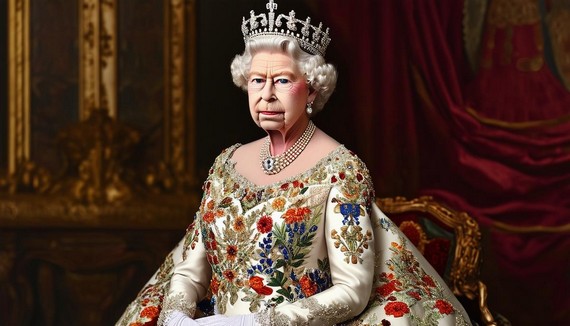
Queen Elizabeth II wearing her Norman Hartnell-designed coronation gown, featuring intricate embroidery of Commonwealth floral emblems
Norman Hartnell – Legacy and Influence
Norman Hartnell’s legacy is imprinted in the essence of royal fashion, his influence extending through decades. By blending tradition with innovation, Hartnell created designs that transcend time, continuing to inspire and captivate.
When Princess Beatrice wore a Hartnell creation for her 2020 wedding, it highlighted the timeless nature of his designs. The gown, once worn by Queen Elizabeth II, wasn’t just vintage; it was a piece of regal fashion history. This choice demonstrated respect for Hartnell’s craftsmanship and the stories woven into his work.
Hartnell’s talent lay in crafting garments that told tales of royalty while capturing the mood of an era. His designs were meant to be worn and experienced, each with its own identity. Princess Beatrice’s choice to revisit one of his creations shows the enduring allure and relevance of Hartnell’s work.
In royal fashion, Hartnell laid groundwork that future designers have built upon. His mixing of opulent materials and attention to detail became a foundation for contemporary designers. While silhouettes may have evolved, the inspiration remains, evident in how designers incorporate symbolism and thematic elements into their creations.
Hartnell’s work lives on wherever royal gowns glisten with tradition and innovation. His designs continue to influence and inspire, proving that true elegance is timeless. Each stitch in a Hartnell gown represents a moment in fashion history and a legacy that echoes in the halls of royal style.
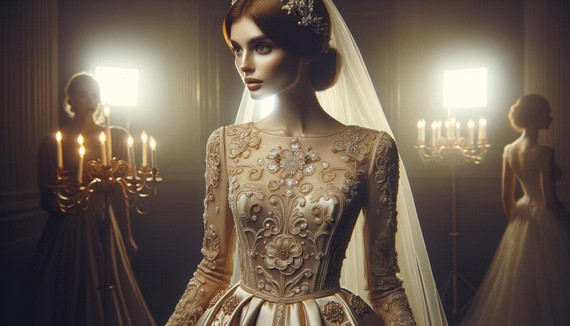
Princess Beatrice wearing a vintage Norman Hartnell gown, originally worn by Queen Elizabeth II, for her 2020 wedding
Hartnell’s legacy endures as a testament to his skill in creating garments that transcend mere fashion. His designs continue to inspire, offering a glimpse into a world where elegance and innovation meet. Through his work, Hartnell has left an indelible mark on royal fashion, reminding us that true artistry in design can bridge past and present with grace and sophistication.
References:
- Pick M. Be Dazzled! Norman Hartnell: Sixty Years of Glamour and Fashion. London: Pointed Leaf Press; 2007.
- Christie’s. A royal bridesmaid’s dress and headdress by Norman Hartnell, 1947. Christie’s Press Release. 2024.
- Hartnell N. Silver and Gold. London: Evans Brothers; 1955.
1930s Fashion Designers – 1930s Hollywood Costume Designers
Hollywood’s golden era showcased fashion that blended glamour, innovation, and costume design artistry. The 1930s Hollywood Costume Designers were creators behind these iconic looks were storytellers, crafting narratives through fabric and form. Their work resonated with audiences, leaving a lasting impression on cinema and fashion.
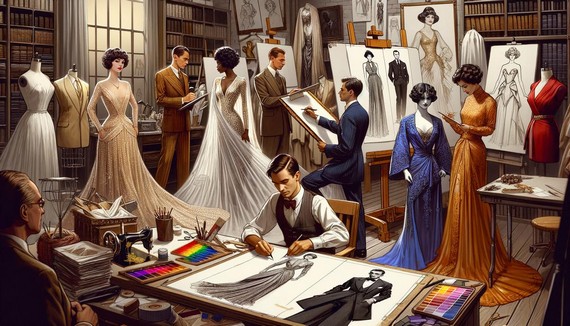
Golden age costume designers
Gilbert Adrian’s Influence on Hollywood Glamour
As MGM’s chief costume designer from 1928 to 1941, Gilbert Adrian redefined Hollywood glamour. His name became synonymous with high fashion, often headlined as “Gowns by Adrian” in the credits. Adrian was a virtuoso of silhouette, crafting contours that complemented star personas, enhancing both their allure and drama.
His work in ‘The Wizard of Oz’ is exemplary. Judy Garland’s ruby slippers became a timeless symbol, captivating the imagination of millions. In ‘The Women,’ Adrian’s designs filled the screen with elegance and excess, blurring the lines between on-screen fashion fantasy and off-screen trendsetting.
Adrian’s influence reached beyond the silver screen, seeping into the wardrobes of everyday cinemagoers. The Adrian Shoulder, with its assertive silhouette, became a fashion phenomenon. Joan Crawford’s power shoulders marked an era, an audacious ode to style and structure.
Adrian’s fashion was a legacy of aesthetic mastery, leaving an indelible mark on 1930s Hollywood costume design. His designs didn’t just cloak the stars; they amplified their light, ensuring that the glamour of 1930s Hollywood wasn’t just seen—it was felt, worn, and lived.
1930s Hollywood Costume Designers – Edith Head’s Rise to Fame
Edith Head’s journey from teaching Spanish to becoming one of cinema’s most prolific 1930s costume designers is a Hollywood legend. She started at Paramount Pictures in the 1920s as a sketch artist, quickly proving her mettle and climbing the ranks.
Head’s unique approach set her apart—an unwavering commitment to character-driven design fueled by extensive dialogues with the stars she dressed, directors, and producers. She had an uncanny ability to read a script and translate it into unforgettable fashion moments on screen.
Her work with Audrey Hepburn in films like ‘Sabrina’ and ‘Breakfast at Tiffany’s’ is etched in cinematic history. Hepburn’s black dress from ‘Breakfast at Tiffany’s’ became more than just a garment; it remains a symbol of sophistication.
Equally notable was her collaboration with Grace Kelly. In ‘Rear Window’ and ‘To Catch a Thief,’ Kelly’s wardrobe was integral to the narrative, enveloping her character with effortless elegance.
Head’s career was decorated with accolades, including a record-breaking eight Academy Awards for Best Costume Design. Her designs were a celebration of the women she dressed, enhancing their star power with silhouettes that were both flattering and ladylike.
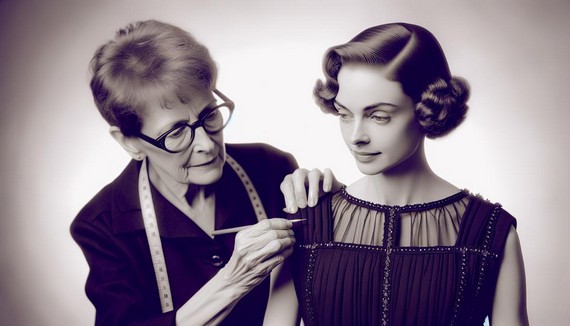
Edith Head adjusting Audrey Hepburn’s iconic black dress from Breakfast at Tiffany’s
Orry-Kelly’s Wearable Designs
Orry-Kelly revolutionized 1930s Hollywood costume design with a refreshingly accessible appeal. Unlike many of his contemporaries, Orry-Kelly created garments that cinemagoers could envision in their own wardrobes. He had the rare gift of translating stellar glamour into styles that resonated with the everyday.
His approach embraced subtle sophistication, mastering what could be called ‘design for distraction.’ Orry-Kelly cleverly used costume to accentuate actors’ strengths while gently veiling any insecurities. His work with Bette Davis in ‘Jezebel’ showcased this vision, where his audacious choice of a fiery red dress in a monochrome palette etched Davis into cinematic legend.
For Marilyn Monroe in ‘Some Like It Hot,’ Orry-Kelly crafted ensembles that exuded both sexiness and elegance—the very essence of Monroe herself. These designs were imbued with a timeless charm that transcended the screen.
His three Academy Award victories for ‘An American in Paris,’ ‘Les Girls,’ and ‘Some Like It Hot’ serve as a testament to his ability to adapt and excel across genres. Orry-Kelly breathed life into each garment, creating pieces that were lived-in, evocative, and responsive to the stories they adorned.
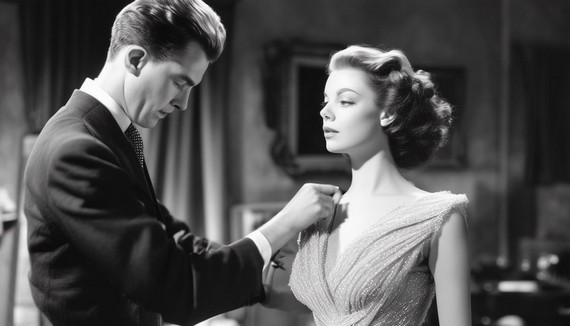
Orry-Kelly fitting Marilyn Monroe in a glamorous costume for Some Like It Hot
Walter Plunkett’s Period Mastery
Walter Plunkett’s genius in period costume design gave rise to some of the most memorable fashion moments in cinematic history. His work on ‘Gone With the Wind’ solidified his reputation as the maestro of period costumes.
Plunkett’s commitment to historical accuracy, combined with a keen artistic eye, ensured that each costume was not merely an outfit but a vibrant relic of the past. The green velvet curtain dress worn by Vivien Leigh as Scarlett O’Hara remains a testament to his ability to weave storyline into sartorial splendor.
His designs were visually captivating and symbolically layered, each garment telling its own story within the grand tale of the American Civil War. Scarlett’s journey through the ravages of war and social upheaval were intricately illustrated through her ever-evolving wardrobe.
Plunkett’s penchant for historical costumes extended to other period pieces like ‘Little Women’ and ‘Singin’ in the Rain,’ reaffirming his versatility and depth as a designer. His creations were imbued with a genuine reverence for the eras he depicted, exuding both authenticity and allure.
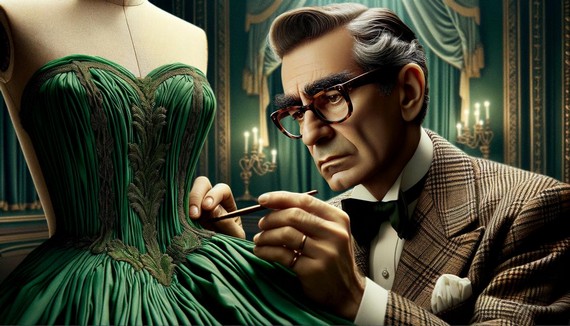
Walter Plunkett examining the green curtain dress from Gone With The Wind
1930s Hollywood Costume Designers – Travis Banton’s Extravagant Creations
Travis Banton’s designs shimmered with artistry that transcended mere fabric. Known for his extravagant creations at Paramount Pictures, he masterfully threaded elegance into every garment, creating a spectacle of style that was both captivating and enigmatic.
His collaboration with director Josef von Sternberg, particularly when crafting Marlene Dietrich’s wardrobe, is legendary. Their partnership bore a symphony of sartorial splendor, with Banton’s costume designs transforming Dietrich into the epitome of sophistication and sensuality. Her wardrobe in films like ‘Shanghai Express’ showcased his penchant for dramatic flair and boldness.
Banton’s influence on 1930s Hollywood costume design fashion was profound. He set the stage for opulence, infusing the screen with an unmatched sense of elegance that carried a distinctly theatrical touch. His designs often featured:
- Lavish detailing
- Deep colors
- Daring cuts ahead of their time
A particular hallmark of Banton’s work was his ability to convey character through clothing. He often worked closely with stars to ensure his designs were an extension of their on-screen personas. Stars like Dietrich didn’t wear Banton’s designs—they inhabited them, their performances enhanced by his visionary artistry.
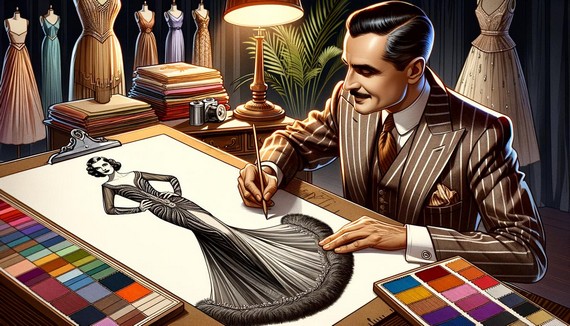
Travis Banton sketching an extravagant costume for Marlene Dietrich
The legacy of these 1930s Hollywood Costume Designers is a testament to their ability to transcend mere fashion, creating garments that continue to inspire and captivate. Their contributions to Hollywood’s allure remain a vibrant thread in cinematic history, reminding us of the enduring power of style and storytelling.
References:
- Kristen Pignuolo. Edith Head: Hollywood’s Costume Queen. Vanity Fair. 2019.
- Larry McQueen. The Collection of Hollywood Costume Design. Fashion Institute of Design & Merchandising Museum. 2018.
- Catherine Shotick. Hollywood Costume. Victoria and Albert Museum. 2012.
1930s Fashion Designers – Jeanne Lanvin Design Style
Jeanne Lanvin began her journey through fashion and is a story of innovation and artistry. Her tale unfolds in the vibrant streets of Paris, where creativity and elegance meet. From her early inspirations to her lasting impact, Lanvin’s legacy is a testament to her visionary spirit and deep understanding of style.
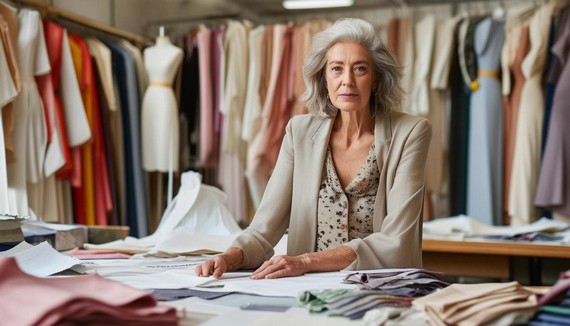
jeanne lanvin in atelier
Jeanne Lanvin – Early Influences and Inspirations
Jeanne Lanvin’s fashion odyssey began in bustling Paris. Born as the eldest in a modest family of eleven children, Jeanne forged a path marked by determination and flair, establishing a cornerstone of elegance and modernity.
Lanvin’s work is intertwined with the arrival of her daughter, Marguerite. Their loving bond made Marguerite not just a muse, but a guiding light for Jeanne’s creative voyage. She crafted enchanting designs for her daughter, sparking interest amongst Parisian mothers who desired the same for their little ones. The allure soon spread to the mothers themselves, expanding Lanvin’s domain.
Lanvin’s design signature bore marks of her artistic escapades and encounters with avant-garde talents, like the Nabis painters. Her friendship with Édouard Vuillard introduced her to a vivid world of colour and artistry, influencing her work and reflecting an elegance gleaming with unexpected brightness.
Jeanne was inspired by travels and curious explorations. Her design philosophy wasn’t about following trends; it was about anticipating them. The vivid hues of her beloved Lanvin blue or the structured playfulness of her robe de style dresses stemmed from her childhood imagination and her encounters with both people and places.
“I act on impulse and believe in instinct. My dresses aren’t premeditated. I’m carried away by feeling, and technical knowledge helps me make my clothes become reality.” – Jeanne Lanvin
Fashion was her language, with each piece telling a tale of grace fused with a modern pulse. Her ateliers were where she weaved her style’s distinct story. Lanvin’s work was a unique melody of colour, form, and feeling resonating with the elegance of her era.
Her legacy lay in shaping women’s wardrobes and an industry, marking time with her creations that endured through decades of change. Jeanne stood at a crossroads of tradition and innovation, speaking a dialect of design that was distinctly Lanvin—one that endures even as the fashion landscape continues to evolve.
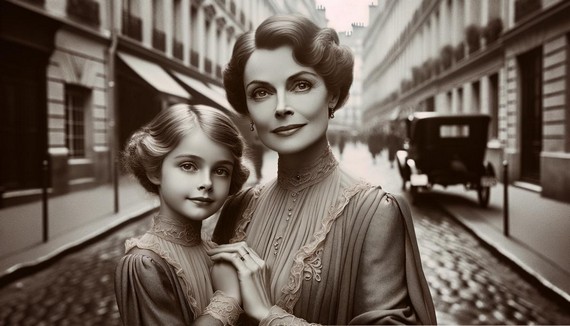
Jeanne Lanvin, a Caucasian woman in her 40s, with her young daughter Marguerite, both elegantly dressed in matching 1910s outfits
Signature Designs and Innovations
Jeanne Lanvin’s artistic vision, crystallised through her signature designs, significantly impacted fashion. Among her many contributions, the ‘robe de style’ stands out. At a time when minimalist silhouettes like the flapper dress were popular, Lanvin offered an alternative that harkened back to 18th-century splendour. Her iconic dresses presented a harmonious blend of a small, snug waist contrasted with a voluminous skirt, offering women a different silhouette.
Lanvin’s mastery of colour was remarkable. The revered “Lanvin blue,” inspired by Fra Angelico, became synonymous with the brand. Jeanne had a talent for capturing moods and feelings through her palette, inviting wearers to embark on a chromatic journey. Her colour choices were vibrant yet understated, breathing life into each piece.
In Jeanne’s world, elegance and femininity were foundational. She understood fashion as a means of personal expression, yet remained committed to her ideals of grace and sophistication. This understanding was bolstered by her insight into women’s needs and desires—a perspective gleaned from the intimacy of mother-daughter relationships.
- Innovative ‘robe de style’ design
- Mastery of color, especially ‘Lanvin blue’
- Focus on elegance and femininity
- Mother-daughter dressing concept
Beyond the flair and sumptuous fabrics, it was Jeanne’s innovative approach that made her a trendsetter. She existed in a sphere where trends waited for her consent before taking form. With each collection, she created fashion waves, setting her designs at the forefront of sartorial discussions.
Jeanne’s influence persists, with the maison she founded continuing to echo her ethos of innovation within tradition, elegance infused with modernity. As the fashion industry evolves, Lanvin is remembered not just as a designer of her time, but as a visionary who shaped the future of fashion.
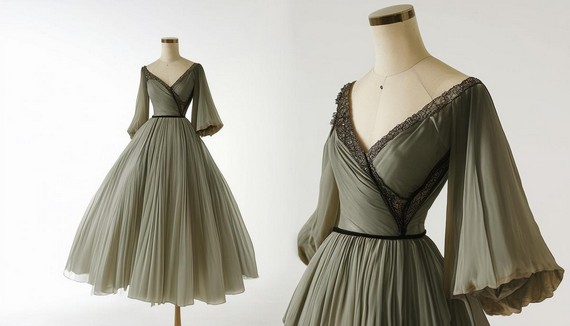
A mannequin wearing an elegant Lanvin robe de style dress from the 1920s, showcasing its distinctive silhouette with a fitted bodice and voluminous skirt
Jeanne Lanvin – Impact on Fashion and Legacy
Jeanne Lanvin’s impact on the fashion world is profound and enduring. Her creations stretched far beyond mere fabric and form, weaving themselves into the social and cultural landscape of her time. One of Lanvin’s most significant contributions was the popularisation of mother-daughter dressing. This concept, initially sparked by her affection for her daughter Marguerite, became emblematic of her brand’s ethos. Lanvin tapped into maternal sentimentality, offering matching ensembles that allowed mothers and daughters to share a sartorial connection.
Lanvin’s work influenced fashion enthusiasts and fellow1930s fashion designers. Her commitment to craftsmanship and keen eye for detail set a benchmark that many aspired to emulate. The elegance of her designs, paired with a modern twist, challenged and inspired contemporaries like Coco Chanel and Christian Dior. Her approach to enhancing femininity while maintaining individuality became a guiding light for future generations in fashion design.
Even beyond her lifetime, Jeanne Lanvin’s fashion house continues to assert its relevance. Under the stewardship of numerous talented designers, including Alber Elbaz in the 21st century, Lanvin has managed to retain its distinctiveness whilst embracing contemporary trends. This blend of heritage and modernity ensures that Lanvin remains a venerated name, celebrated for its timeless yet trend-aware collections.
The enduring legacy of Lanvin can be observed in its commitment to the principles Jeanne held dear: elegance, colour, and a touch of the avant-garde. Today, the house continues to craft garments that speak to both tradition and innovation. With each creation, Lanvin continues to captivate and inspire, proving that true style and vision are perpetually chic, regardless of passing fads.
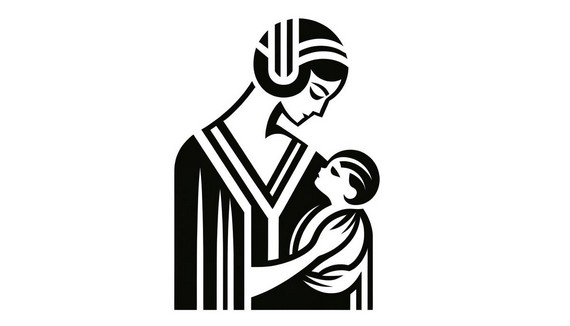
The iconic Lanvin logo featuring a stylised Art Deco illustration of a mother and child, symbolising the brand’s heritage
Jean Lanvin’s Artistic Collaborations
Jeanne Lanvin’s ingenuity extended beyond her own ateliers through various artistic collaborations. One of the most significant was with artist Paul Iribe, whose art deco style resonated with the modern yet timeless aesthetic that defined Lanvin’s work.
With Iribe, Lanvin created the iconic mother and child logo, which gracefully embodied the essence of the brand. This emblem, a tribute to her relationship with her daughter Marguerite, adorned garments with an understated yet poignant mark of identity. Iribe’s influence can also be felt in the graphic elegance of her collections, where artistic lines blurred with sartorial contours.
Collaborations with artists from the Nabis movement enriched the textures and colours that became synonymous with the Lanvin aesthetic. Jeanne’s appreciation for art was mirrored in the playful dance of colours within her creations, where vivid hues often found inspiration from her friendships with artists who shared her passion for colour and form. Her distinctive Lanvin Blue, as vivid as a Fra Angelico fresco, painted her creations with a celestial hue that spoke of her artistic connections.
These partnerships infused Lanvin’s collections with a vibrancy and intricacy that made them stand apart. It was about integrating artistic themes into the core of her designs, ensuring that her pieces carried the resonance of a deeper cultural conversation. The relationship between art and fashion allowed Lanvin to push boundaries, paving the way for her collections to transcend mere clothing into the realm of expression.
Through these artistic exchanges, Jeanne Lanvin enriched her brand’s visual language and contributed significantly to its enduring identity. She intertwined artistic sensibilities with fashion stories, creating pieces that echoed her innovative spirit and left an indelible mark on the industry. This fusion of creativity established Lanvin as a hallmark of elegance and innovation, a legacy that continues to inspire artists, designers, and fashion enthusiasts alike.
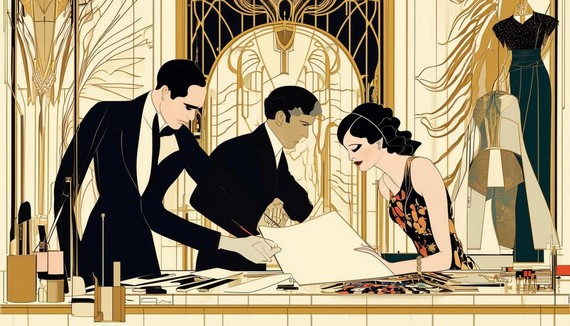
Jeanne Lanvin and Paul Iribe, both Caucasian, collaborating on a design in Lanvin’s Parisian atelier, surrounded by Art Deco elements
Jeanne Lanvin’s enduring influence lies in her ability to blend tradition with modernity, crafting garments that resonate with timeless elegance. Her work continues to inspire, reminding us that true style transcends fleeting trends and remains ever relevant.
References:
- Vogue. Jeanne Lanvin: One of the Great Women of the World. Vogue. 1927.
- Dior C. Dior by Dior: The Autobiography of Christian Dior. London: V&A Publications; 2007.
1930s Fashion Designers – Mainbocher Corset Innovations
In fashion, the contributions of Mainbocher stand as a testament to the enduring power of elegance and innovation. His work in corsetry and garment design speaks volumes about the intersection of tradition and modernity, offering a story that resonates with timeless sophistication.
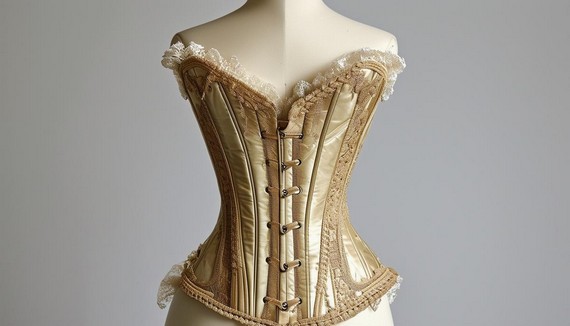
mainbocher corset elegance
Mainbocher’s Design Philosophy
Mainbocher, a couturier whose clients included the ‘perfectly groomed woman of distinction and strong character’, embraced an aesthetic balancing restraint with opulence. In corset-making, his approach was precise yet unadorned. He revived a silhouette that gently traced the contours of the female form, favoring a shape with a full bust and defined waist.
Through his corsetry, Mainbocher challenged the transience of fashion trends. His designs were not just visual treats but communicated the essence of sophistication. Simplicity turned into a symphony of structured elegance in his hands. His idea of the little black dress and the introduction of the strapless style were testaments to his philosophy prioritizing timelessness over gimmickry.
The “Mainbocher Corset,” immortalized by Horst P. Horst in his iconic photograph, intertwined emotion and craftsmanship. The image captured an era’s apprehensions—the slender waist and pooling ribbons mirroring a world on the brink of change.
Mainbocher’s corsetry wasn’t just an exercise in sewing but also clever storytelling. It sparked dialogue, set itself against the fast pace of fleeting fads, and stood as a testament to the beauty of simple, classic lines. By prioritizing the artifact’s symbolism over ornamental opulence, Mainbocher stitched his values into every seam, weaving a story of timeless grace into couture.
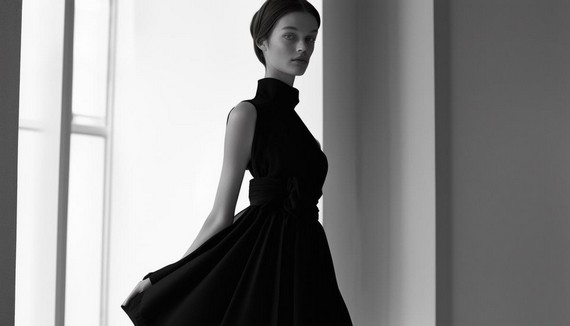
A model wearing a Mainbocher-designed little black dress, emphasising simplicity and sophistication
Innovative Corsetry Techniques
Mainbocher’s innovative approach to corsetry blended precise technique with forward-thinking fabric innovations. His corsets were distinguished by their structural finesse and nuanced artistry. He introduced construction techniques that elevated his designs beyond mere utility, turning them into symbols of sophisticated allure. His approach capitalized on contour-fitting fabric orientations, ensuring each corset gently embraced its wearer while offering a comfortable fit.
Mainbocher’s playful yet deft use of materials set him apart. He frequently employed:
- Costume-dyed furs, infusing traditional corset designs with tactile opulence
- Knitwear, creating iconic beaded evening sweaters
- Variety of fabrics with contrasting weights and textures
This ingenious coupling of different materials spoke volumes about his ability to blend different worlds. His innovative usage of materials became his hallmark, challenging his contemporaries to think outside the confines of conventional fashion rules.
Through his radical reimagination of corsetry, Mainbocher was sculpting silhouettes that provided an emotional resonance, marked by their intimate craftsmanship and depth. His works served as a reflection of his enduring philosophy: fashion, much like art, holds the power to tell stories that linger far beyond the seams and stitches.
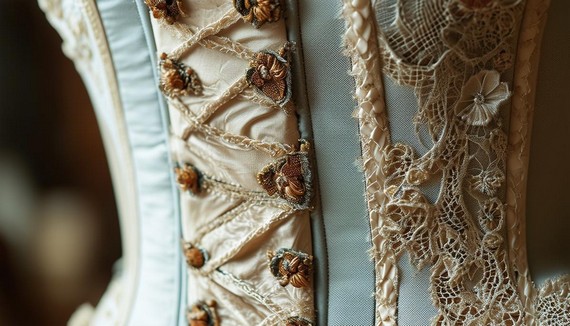
Close-up of a Mainbocher corset, showcasing innovative fabric techniques and intricate detailing
Cultural Impact of Mainbocher’s Corsets
Mainbocher’s corsets were powerful cultural symbols reflective of the societal norms of his era. For his discerning clientele, these garments encapsulated a sense of refined exclusivity that resonated with the upper echelons of society. They were status markers, differentiating those who adorned them from the everyday sartorial shuffle.
The societal expectations of the time were intricately woven into Mainbocher’s designs. His corsets embraced the traditional hourglass silhouette, a nod to femininity that was both celebrated and prescribed for women of the era. In a world that expected restraint and decorum, Mainbocher’s garments provided a way for women to communicate a sense of personal strength.
This notion of power and elegance was immortalized in the image captured by Horst P. Horst, where the poised yet introspective presentation of the model encapsulated an era’s intricacy. The model’s hidden face and bound form echoed a societal sentiment of constraint, yet in Mainbocher’s hands, it represented a controlled grace.
Mainbocher’s corsets transcended beyond the personal to comments on societal ideals. The careful construction and polished finish served to remind of the societal pressures for perfection and the delicate balance of public presentation and personal identity.
However, within this structure and expectation, there lay a nuanced rebellion. Mainbocher’s use of unconventional materials and experimental techniques breathed new life into an otherwise traditional silhouette, suggesting a desire for progression within the confines of classicism. His work encouraged a subtle shift in how women could express themselves within those societal norms.
As representatives of Mainbocher’s lasting impact, his corsets continued to influence fashion, serving as both sartorial staples and cultural barometers. They remind us today of the delicate interplay between tradition and innovation, and the timelessness of true style that transcends the fleeting nature of fashion.
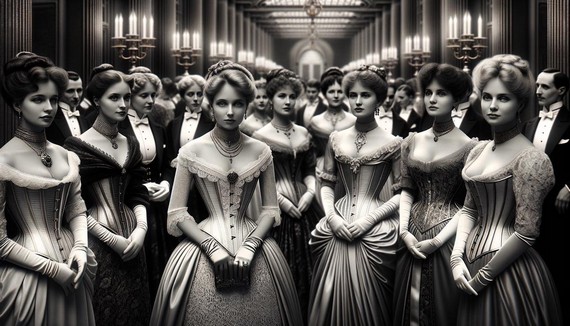
A high-society event featuring women wearing Mainbocher corsets, illustrating their cultural significance
Horst P. Horst’s Iconic Photograph
Horst P. Horst’s iconic photograph of the Mainbocher Corset transcended mere fashion documentation to become a poignant symbol of the era’s intricacies. This striking image, immortalized in stark black and white, reflected both the elegance of Mainbocher’s designs and the emotional turbulence of a world on the brink of war.
The photograph depicts a model with her face obscured and her torso encased in the sinuous embrace of a Mainbocher corset. The contrasting lines of the corset highlight her slender waist, while the fabric’s soft pooling ribbons suggest both a sense of graceful unraveling and the hidden tensions of the late 1930s.
“It was the last photograph I took in Paris before the war. I left the studio at 4:00 am, went back to the house, picked up my bags, and caught the 7:00 am train to La Havre to board the Normandie. We all felt that war was coming. Too much armament, too much talk. And you knew that whatever happened, life would be completely different after…. This photograph is peculiar—for me, it is the essence of that moment. While I was taking it, I was thinking of all that I was leaving behind.” – Horst P. Horst
This composition intertwines the personal with the universal, presenting a visual story that speaks to themes of control and vulnerability. It portrays a juxtaposition between the poised elegance of the corset and the palpable melancholy of a concealed face, capturing the duality of a society caught between the allure of timeless beauty and the shadows of political unrest.
By evoking echoes of the historical imagery of Velázquez’s “Rokeby Venus,” Horst harnessed the power of art history to communicate timeless ideas of beauty and transformation. This artistic strategy enriched the photograph’s cultural significance, offering a rich collection of intertextual allusions that resonated deeply within the societal consciousness of its time.
The emotional depth Horst captured in this photograph prompted a shift in the paradigms of fashion photography. It encouraged photographers to explore the emotional layers beneath the surface of elegance, sparking a legacy of fashion imagery laden with complexity and human sentiment.
Through his photograph, Horst elevated fashion imagery to new heights, intertwining artistic expression with profound cultural commentary, and leaving an indelible mark on fashion photography.

A recreation of Horst P. Horst’s iconic Mainbocher Corset photograph, capturing its timeless elegance
Mainbocher’s Legacy in Fashion
Mainbocher’s legacy in fashion, particularly within American couture, continues to reverberate through the annals of sartorial history. By seamlessly blending innovation with classic sophistication, Mainbocher set a precedent for what American 1930s fashion designers could achieve, encouraging them to cherish their own heritage rather than merely mimicking European trends.
Known as the first American to own a couture house in Paris, Mainbocher’s transition to New York during World War II reflected a bold move that showcased his adaptability and commitment to preserving the art of couture amid global upheaval. This relocation marked a significant shift in the fashion world, helping to position the United States as a burgeoning center for high fashion.
Central to Mainbocher’s enduring influence was his innovative approach to corsetry and garment construction. His precise fabric orientation and contour-fitting techniques set new standards for sewing. These elements of precision and craftsmanship became touchstones for other 1930s fashion designers who sought to create garments that flattered the wearer while maintaining an air of understated elegance.
Mainbocher’s playful dichotomy of materials—juxtaposing weighty with light, or rich with subtle—paved the way for exploration in fabric engineering. Such experimentation inspired countless 1930s fashion designers to push the boundaries of traditional couture, transforming fashion into a dynamic intersection of art and innovation.
Another defining aspect of Mainbocher’s legacy is his introduction of iconic styles that withstand the test of time. The little black dress and the strapless gown, both innovations under Mainbocher’s direction, embodied both modernity and classic allure.
Mainbocher’s legacy is further cemented by his ability to weave cultural themes through his designs. He understood that fashion could be a potent tool for communication, one that could subtly critique, reflect, or reform social norms.
His influence continues to ripple through the industry, touching the works of contemporary designers who find inspiration in his philosophy. By prioritizing the enduring over the ephemeral, Mainbocher set a standard for quality and artistry that has become a guiding principle for future generations.
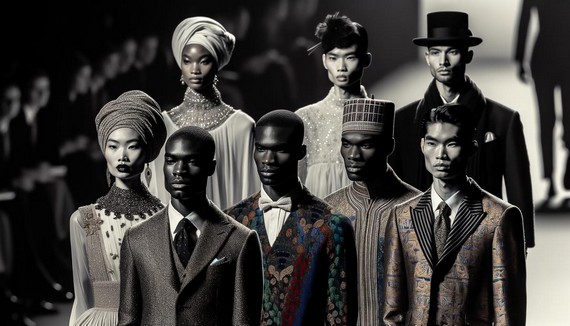
A modern fashion runway showcasing designs inspired by Mainbocher’s legacy
Mainbocher’s legacy continues to inspire, reminding us that true elegance lies in the subtle balance of innovation and tradition. His work remains a beacon for those who appreciate the quiet strength of fashion’s enduring grace.
References:
- Horst P. Horst. Mainbocher Corset. Vogue. 1939.
- Vanderbilt G. The Glory of Gloria Vanderbilt. New York: Alfred A. Knopf; 2010.
- Mainbocher: Crafting American Couture. The Museum at FIT. 2012.
1930s Fashion Designers – Elsa Schiaparelli Surrealist Fashion
From her trompe l’oeil sweater to collaborations with surrealists, Elsa Schiaparelli consistently challenged norms and embraced the unexpected. Elsa Schiaparelli’s journey through fashion is a testament to creativity and innovation. Her early works, marked by playful designs and bold choices, set the stage for a career that would redefine how we perceive clothing.
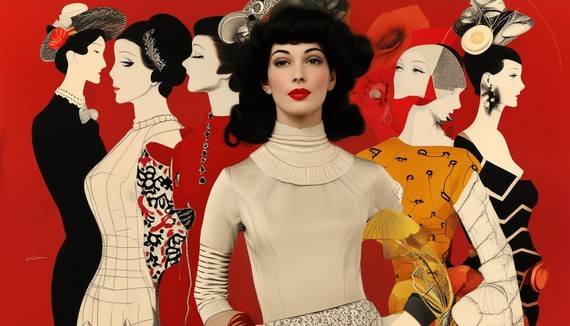
schiaparelli fashion legacy
Elsa Schiaparelli’s Early Innovations
Elsa Schiaparelli’s early ventures began with a sweater. It wasn’t just any sweater, though; it was a trompe l’oeil masterpiece that cleverly created the illusion of a bow. This design in 1927 marked the start of her journey from novelty to icon. Fashion enthusiasts were captivated by what looked like a bow tie, creating a stir in Paris and beyond. Vogue and The New Yorker praised it for its cleverness and boldness.
While the trompe l’oeil sweater gained attention, Schiaparelli also revolutionized the use of zippers. Before her, zippers were merely functional. She turned them into fashionable features, making them visible parts of haute couture garments. This bold move aligned with her signature style of combining eccentricity with elegance.
These innovations were just the beginning. The trompe l’oeil motif went beyond mere fashion; it was an intellectual exercise wrapped in wool and whimsy. It prepared Elsa Schiaparelli for more adventurous designs, including her whimsical Lobster Dress and the iconic Shocking Pink. The humble sweater and the daring zipper set the stage for larger-than-life collaborations with artists like Salvador Dalí, blending art and attire in new ways.
Elsa Schiaparelli’s early work laid down a new path where imagination reigned. Echoes of her exploratory leap can still be found today in runways and high-street stores alike, where creativity is as much in vogue as elegance.
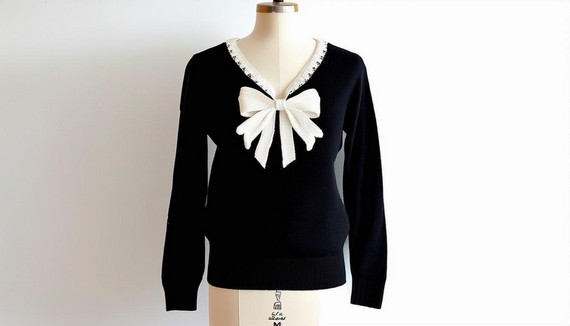
A black sweater with a white trompe l’oeil bow design at the neckline, displayed on a vintage mannequin
Elsa Schiaparelli – Collaborations with Surrealists
Elsa Schiaparelli’s collaborations with surrealists created masterpieces that challenged conventional fashion. Salvador Dalí was at the forefront of these partnerships. Their most memorable creation, the Lobster Dress, unveiled in 1937, was a sensational piece that brought together art and fashion in a unique way. Crafted from white silk organza and adorned with a painted lobster motif, it was both beguiling and bewildering.
Dalí’s influence was also visible in the Skeleton Dress from 1938, which featured quilted ribs and vertebrae. This audacious creation turned the female silhouette into an exploration of the macabre—a somber yet striking representation of the human form. The dress didn’t just embellish the body; it redefined it, challenging traditional haute couture.
Jean Cocteau, another notable collaborator, brought a different shade of surrealism to Elsa Schiaparelli’s work. The famed evening coat with its trompe l’oeil twin faces, created in 1937, was a striking blend of Cocteau’s surreal vision and Schiaparelli’s rebellious elegance.
These partnerships elevated Schiaparelli’s design philosophy, cementing her reputation as fashion’s daring visionary. Each piece from these collaborations spoke of more than artistic genius; they presented a reality twisted and brilliant, where garments became gateways to dreams and dialogue.
Through these captivating collaborations, Elsa Schiaparelli brought surrealist imagery to the runways long before it became a trend. Her ability to weave art with fabric transformed her creations into veritable works of art. These creations still echo through haute couture today, a testament to Schiaparelli’s bold approach to fashion design.
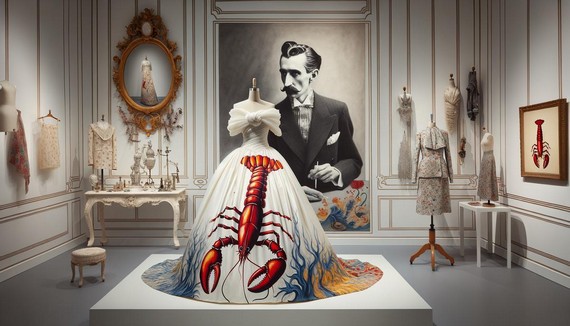
The Lobster Dress, a white silk organza gown with a large red lobster painted on the skirt, displayed next to a portrait of Salvador Dalí
Iconic Collections and Themes
Elsa Schiaparelli’s imagination shone brightly in her iconic collections, where art and fashion collided in a kaleidoscope of imagery. Her Circus Collection, introduced in 1938, was a sartorial spectacle inspired by the whimsical world of circus performers. Schiaparelli translated the exuberant essence of the circus into fabric, creating an ode to performance laced with intricate embroidery and playful patterns.
The collection featured designs that embodied the fantastical spirit of the circus:
- Jackets adorned with acrobat motifs
- Blouses echoing the spectacle of ringmasters
- Bold colors and unexpected details
Equally captivating was Schiaparelli’s Zodiac Collection of 1938. Inspired by astrology and the mystique of the cosmos, Schiaparelli wove constellations and astral motifs into her designs. This collection dazzled with delicate embroidery and shimmering fabrics, bringing the ethereal allure of the stars into fashion. Each piece told a story, transforming garments into visual tales filled with meaning and emotion.
Across her collections, Schiaparelli seamlessly merged art with design, using fashion as her canvas to explore whimsical and evocative themes. Her ability to encapsulate entire worlds within a single garment was extraordinary, lending her work a timeless quality. From the rhythmic gaiety of the Circus Collection to the celestial elegance of the Zodiac Collection, Schiaparelli’s designs continue to captivate, their allure unfading as they echo through fashion history.
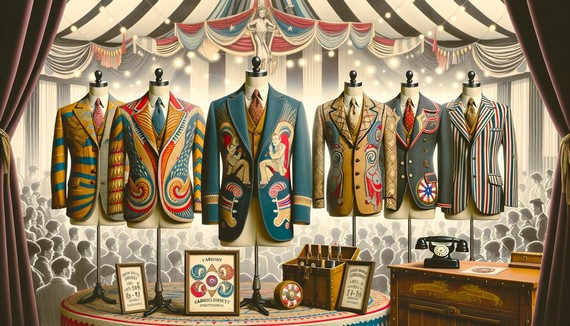
A vibrant display of Schiaparelli’s Circus Collection, featuring jackets with acrobat motifs and blouses with ringmaster-inspired designs
Elsa Schiaparelli – Legacy and Modern Influence
Elsa Schiaparelli’s mark on fashion continues to influence modern creators. Her work wasn’t just about garments; it was an avant-garde declaration that defies time. Elsa Schiaparelli’s legacy, with its bold use of color and unapologetic innovation, resonates in today’s fashion climate, inspiring designers seeking the extraordinary.
Her audacious use of shocking pink remains a vibrant symbol of creative freedom in fashion. This brilliant color is continually revisited by contemporary designers as a nod to Schiaparelli’s courage to blend whimsy with boldness. Today, the fashion industry often turns to bold colors to make similar statements, understanding the power of hues in clothing.
Schiaparelli’s surrealist collaborations, particularly with Salvador Dalí, established a new form of expression in fashion, where clothes became art pieces. This intermingling of surrealism with fashion initiated a tradition of artistic integration, which contemporary designers continue to embrace. Today, we see collections adorned with surreal prints and unexpected motifs—elements directly echoing Schiaparelli’s approach.
Under the current artistic direction of Daniel Roseberry, the maison continues to harness this rich inheritance. Roseberry’s leadership sees the Schiaparelli essence flourishing, with collections that draw on the fantasy and surrealism that Elsa skilfully wove into her legacy. This is evident in pieces like:
- The updated version of the Skeleton Dress
- Breathtaking floral motifs combining historical reverence with contemporary flair
The modern fashion landscape owes much to Schiaparelli’s pioneering spirit. She set in motion an artistic revolution that encourages designers to embrace eccentricity, broadening the canvas upon which they create. The maison today acts as a custodian of Elsa’s dreamscape, perpetuating her distinctive voice while innovating within the bounds of that legacy.
In a world where fashion often seeks to blend the past with the future, the boldness of Schiaparelli’s vision remains a source of inspiration. Her commitment to creativity is a call to designers everywhere to push beyond the mundane, to create something unexpectedly marvelous. Thus, her legacy is more than a remembrance; it is a continuing dialogue with the past, written anew in the language of the present.
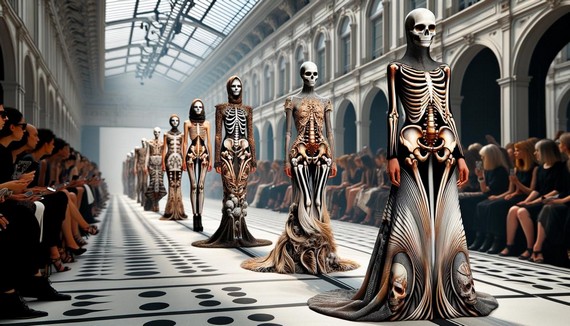
A modern Schiaparelli runway show featuring Daniel Roseberry’s designs, including an updated version of the Skeleton Dress and surrealist-inspired pieces
References:
- White P. Elsa Schiaparelli: Empress of Paris Fashion. Rizzoli; 1986.
- Flanner J. Profiles: A Lightning-Rod Fashion. The New Yorker. 1932;8:22-26.
- Blum D. Shocking! The Art and Fashion of Elsa Schiaparelli. Yale University Press; 2003.
1930s Fashion Designers – Elsa Schiaparelli Impact
Elsa Schiaparelli’s journey through fashion is a testament to creativity and innovation. Her life and work offer a vivid picture of how art and design can intertwine, challenging conventions and inspiring generations.
Schiaparelli’s Early Life and Career
Born in Rome in 1890, Elsa Schiaparelli was a trailblazer from the start. Her rebellious spirit manifested early when, at just six, she ran away from home to lead a parade. Facing family criticism, Schiaparelli’s determination only grew stronger. By 22, she had published a book of poetry that scandalized her aristocratic family.
After a brief marriage that brought her to New York, Schiaparelli began shaping her future in fashion. In Paris, she found herself amongst the avant-garde and Surrealist communities. By the late 1920s, her iconic trompe l’oeil sweaters had catapulted her label into the limelight.
Collaborations with artists like Salvador Dalí and Jean Cocteau turned her designs into living canvases. The surreal nature of her work, such as the Skeleton Dress, merged art with practicality in fresh ways. Schiaparelli’s designs spoke to the modern woman’s spirit, blending innovation with accessibility.
Her early life experiences cultivated a garden of creativity that would redefine the fashion landscape for generations to come.
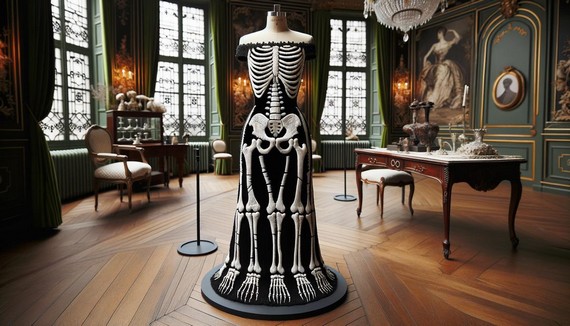
Schiaparelli’s Skeleton Dress, a black gown with white padded ridges creating a skeletal illusion
Innovative Designs and Techniques
Schiaparelli’s approach to fashion was revolutionary. She redefined what clothing could represent, infusing Surrealism into her work and transforming garments into conversation pieces. The Lobster Dress, created with Salvador Dalí, exemplified her ability to merge high art with haute couture.
Her clever use of trompe l’oeil created optical illusions that engaged both wearer and observer. Schiaparelli’s penchant for unconventional materials saw her juxtaposing the familiar with the unexpected. Her use of the zipper as a centerpiece marked a departure from convention and showcased her readiness to incorporate technology into her designs.
Schiaparelli’s celebration of oddity through novelty embellishments, like buttons shaped like insects, transformed simple garments into expressive art pieces. The use of embroidery by the House of Lesage added layers of sumptuous detail to her creations.
From butterfly-adorned outfits to evening suits pairing sleek dresses with ornate jackets, Schiaparelli demonstrated her genius for blending practicality with fantasy. Her work encouraged wearers to embrace whimsy with confidence, breaking free from sartorial monotony.
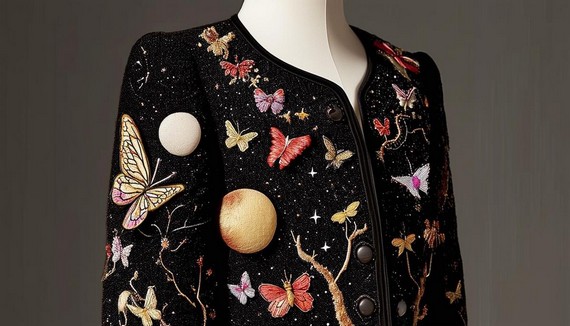
A Schiaparelli embroidered evening jacket with surrealist motifs like butterflies and celestial bodies
Collaborations with Artists
Elsa Schiaparelli’s collaborations with surrealist artists reimagined fashion as a vibrant mix of artistic imagination. Her partnership with Salvador Dalí produced creations that pushed the boundaries of couture, such as the iconic “Shoe Hat” and the audacious Skeleton Dress.
Jean Cocteau was another artistic muse whose partnership expanded the lexicon of fashion design. Their work together featured sumptuous embroideries that transformed clothing into living portraits. Cocteau’s illustrations, rendered in carefully crafted embroidery, adorned flowing gowns, creating a textile story that was as much a feast for the eyes as it was a testament to collaborative creativity.
These partnerships allowed Schiaparelli to weave the allure of the surreal into the very fabric of fashion. Her work with these artists endowed her collections with an ineffable creativity that continues to influence contemporary designers. By embracing the surrealists, Schiaparelli honored the power of collaborative synergy, creating a rich visual dialogue that juxtaposed the whimsical with the wearable.
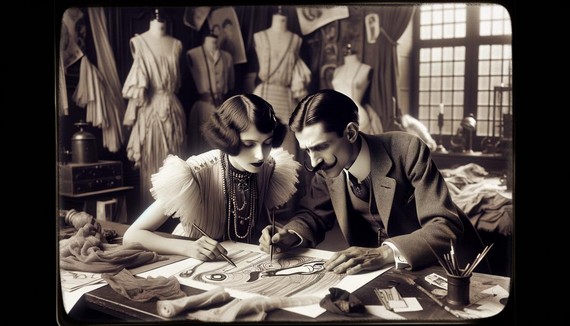
A Schiaparelli embroidered evening jacket with surrealist motifs like butterflies and celestial bodies
Impact on Fashion Industry
Elsa Schiaparelli’s influence on the fashion industry was revolutionary, shifting paradigms and nurturing a legacy of creativity. During the interwar years, when austerity often defined style, Schiaparelli embraced an avant-garde aesthetic that celebrated risk-taking and individualism.
Her designs brought high fashion to a diverse clientele, attracting non-conformist spirits who yearned for bold and striking pieces. Schiaparelli’s work significantly advanced the integration of new technology and textiles into haute couture, challenging the fashion community to adopt a more forward-thinking approach.
Schiaparelli’s influence extended beyond the catwalks, reshaping perceptions and encouraging women to dress for themselves rather than society’s ideals. Her avant-garde appeal coaxed women from the confinement of conformity, inviting them into a playground where whimsy and sophistication coalesced.
In many ways, Schiaparelli laid the groundwork for the modern fashion landscape’s exploration of gender fluidity and social commentary. Her legacy is inseparable from the ongoing story that fashion, at its zenith, offers a dialogue with culture, uniting the tactile and the celestial.
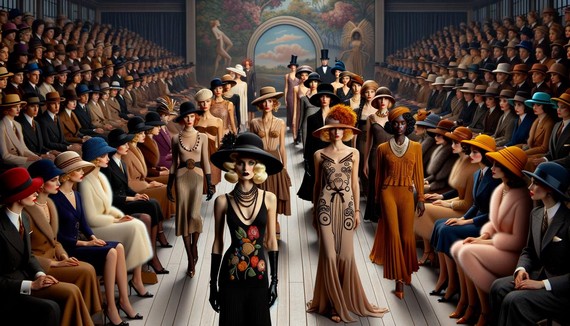
A 1930s Schiaparelli fashion show featuring models in avant-garde designs on a Parisian runway
Elsa Schiaparelli’s legacy is a reminder that fashion can be a powerful form of self-expression, blending art and individuality in every stitch. Her influence continues to inspire those who dare to embrace creativity and challenge the ordinary.
References:
- Secrest M. Elsa Schiaparelli: A Biography. Knopf; 2014.
- Blum D. Shocking! The Art and Fashion of Elsa Schiaparelli. Philadelphia Museum of Art; 2003.
- White P. Elsa Schiaparelli: Empress of Paris Fashion. Rizzoli; 1986.
1930s Fashion Designers – Madeleine Vionnet’s Bias Cut
Madeleine Vionnet‘s journey through fashion is a testament to innovation and elegance. Her story unfolds with the grace of her designs, offering a glimpse into how one woman’s vision reshaped the way we perceive clothing. Vionnet’s influence continues to ripple through time, leaving an indelible mark on fashion history.
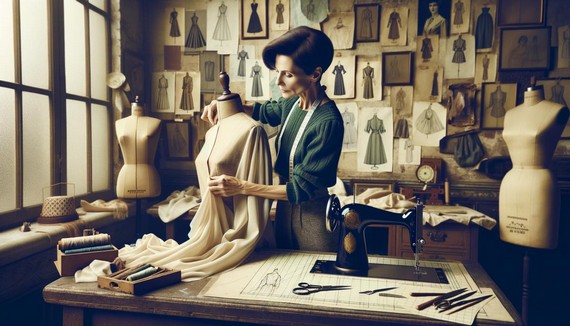
Vionnet draping fabric
The Origins of Madeleine Vionnet
Born in 1876 in Chilleurs-aux-Bois, Madeleine Vionnet found her way into the fashion industry at just 12 years old as a lace maker in Paris. After a brief stint in London working for court dressmaker Kate Reilly, Vionnet returned to Paris in 1900. She honed her skills at prestigious fashion houses like Callot Soeurs and Doucet, mastering the art of sewing and draping.
In 1912, Madeleine Vionnet made her first attempt at opening her own fashion house. Though initially unsuccessful, she persevered and tried again in 1918. This time, her innovative approach to design flourished. Vionnet revolutionized fashion by expanding the use of the bias cut technique, transforming it from a minor detail used for collars into a groundbreaking method for creating entire garments.
Madeleine Vionnet’s designs were characterized by their ability to drape and flow with the body’s natural curves, eschewing the rigid corsetry of the past. Her work with delicate fabrics like chiffon and satin showcased her talent for creating elegantly simple yet sophisticated garments. As her reputation grew, Vionnet’s fashion prowess became the talk of Paris, marking her as a true pioneer in the world of haute couture.
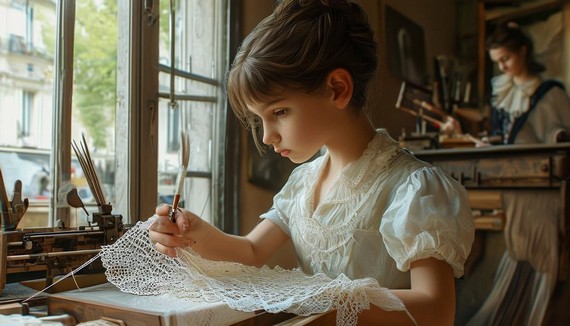
A young Madeleine Vionnet, around 12 years old, working as a lacemaker in Paris
Madeleine Vionnet – The Innovation of the Bias Cut
The bias cut was Vionnet’s signature technique, transforming the way fabric interacted with the body. By cutting fabric at a 45-degree angle to its grain, Vionnet created garments that draped beautifully and moved fluidly with the wearer. This method allowed the fabric to stretch and cling in a way that accentuated natural curves without the need for restrictive undergarments.
Vionnet’s bias-cut designs spoke a language of freedom, replacing the constriction of corsets with graceful sophistication. The technique wasn’t just about the cut; it was about the artistry of the drape, creating clothes that seemed to dance with every movement.
“When a woman smiles, then her dress should smile too” – Madeleine Vionnet
Her clients were captivated by garments that made them feel both elegant and comfortable. The bias cut became more than a technique; it was a statement against the sartorial constraints of the past. Vionnet’s approach to design emphasized body-friendliness, enabling women to move naturally and carry their ensembles with confidence.
This innovative method of cutting and draping fabric has left a lasting impact on fashion design, influencing fashion designers for generations to come. Vionnet’s bias cut remains a testament to her ability to blend art and craftsmanship in clothing design.
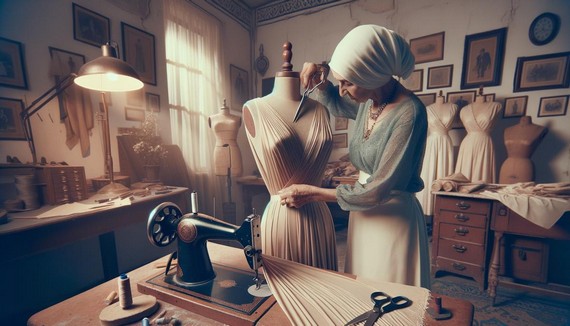
A seamstress demonstrating the bias cut technique on a dress form, showing how the fabric drapes at a 45-degree angle
Impact on Women’s Fashion
Vionnet’s bias cut technique ushered in a new era of women’s fashion in the 1930s. Her designs rejected the rigidity of previous styles, instead celebrating the body’s natural contours. This shift represented more than just an aesthetic change; it reflected evolving societal attitudes towards women’s freedom and self-expression and a reflection of this in the designs created by 1930s fashion designers.
Hollywood stars like Jean Harlow and Bette Davis popularized Vionnet’s designs, cementing the bias cut’s association with glamour and sophistication. This influence trickled down to broader fashion trends, favoring dresses that glided rather than clung to the body.
Vionnet’s approach to design prioritized both beauty and comfort, a concept that resonated with women embracing new freedoms in the post-1920s era. Her work inspired a movement towards authenticity in fashion, where the sensation of wearing a garment became as important as its appearance.
As the 1930s progressed, Vionnet’s influence persisted, inspiring 1930s Fashion Designers to create clothing that celebrated movement and ease. Her legacy transformed the landscape of women’s fashion, blending art, comfort, and elegance in a way that continues to influence designers today.
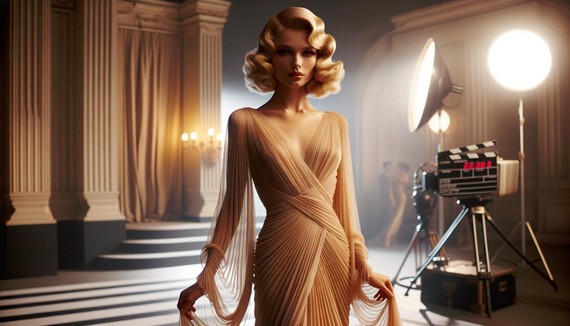
A 1930s Hollywood actress, resembling Jean Harlow, wearing a glamorous Vionnet-designed bias cut gown
Madeleine Vionnet’s Legacy and Influence
Vionnet’s impact on fashion endures long after her retirement from haute couture. Her innovative bias cut technique continues to inspire contemporary designers, from Issey Miyake to Azzedine Alaïa. These designers draw on Vionnet’s ability to blend simplicity with sophistication, focusing on fabric’s natural ability to enhance and empower the wearer.
Modern fashion houses still reference Vionnet’s principles, finding in her work a balance between tradition and innovation. Her “less is more” philosophy challenges current creators to prioritize finesse over flourishes, advocating for an organic design process that allows garments to complement the body naturally.
Vionnet’s legacy extends beyond specific techniques to encompass a broader philosophy of design. Her approach, which valued comfort as much as style, remains relevant to today’s fashion-conscious consumers who seek both elegance and ease in their clothing.
As each new fashion season unfolds, Vionnet’s influence can be seen in the fluid lines and draped silhouettes that grace runways worldwide. Her work continues to inspire designers to explore new frontiers in fashion, blending artistry with wearability in ways that honor her pioneering spirit.
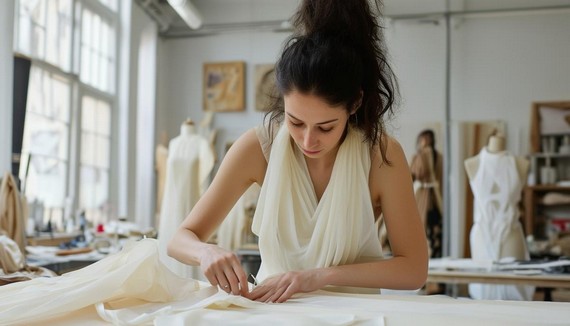
A contemporary fashion designer working on a Vionnet-inspired dress in a modern atelier
Vionnet as a Businesswoman
Madeleine Vionnet’s influence extended beyond her designs to her business practices. She campaigned for the legal recognition of fashion designs, founding the Association for the Defence of Fine and Applied Arts in 1921. This initiative laid the groundwork for modern fashion copyright laws, allowing designers to protect their creative work.
Vionnet also pioneered progressive workplace policies in her atelier. She offered her employees:
- Healthcare
- Maternity leave
- Paid holidays
- Comfortable seating
These benefits were rare in her time, demonstrating a holistic view of her business that prioritized both creativity and employee well-being.
These forward-thinking business practices set Vionnet apart as both a fashion designer and an entrepreneur. Her efforts to protect intellectual property and improve working conditions have had a lasting impact on the fashion industry, influencing how modern fashion houses operate and value their creative output.
Vionnet’s legacy as a businesswoman is as significant as her contributions to design. She showed that success in fashion could be achieved through a combination of artistic vision and ethical business practices, setting a standard that continues to inspire the industry today.
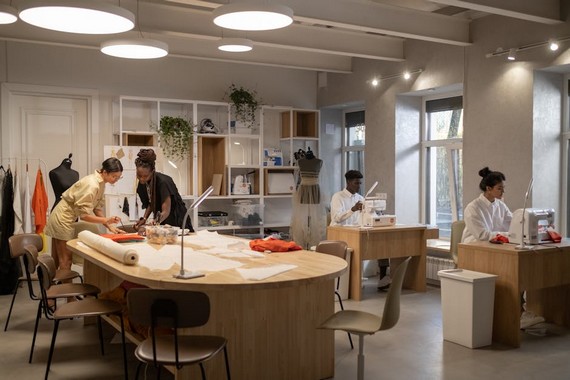
Madeleine Vionnet’s atelier showing employees working in comfortable conditions with good lighting and ergonomic seating
Vionnet’s legacy lies in her ability to blend artistry with functionality, crafting garments that celebrated the natural form. Her pioneering spirit remains a guiding light for designers today, reminding us that true elegance is timeless and transformative.
References:
- Vreeland D. Madeleine Vionnet. New York: Metropolitan Museum of Art; 1985.
- Kirke B. Madeleine Vionnet. San Francisco: Chronicle Books; 1998.
- Golbin P. Madeleine Vionnet. New York: Rizzoli; 2009.
1930s Fashion Designers – 1930s Menswear Designers
The 1930s was a period marked by significant shifts in men’s fashion, driven by economic challenges and cultural influences. As 1930s Menswear Designers crafted styles that balanced practicality with elegance, they left a lasting impact on wardrobes worldwide.
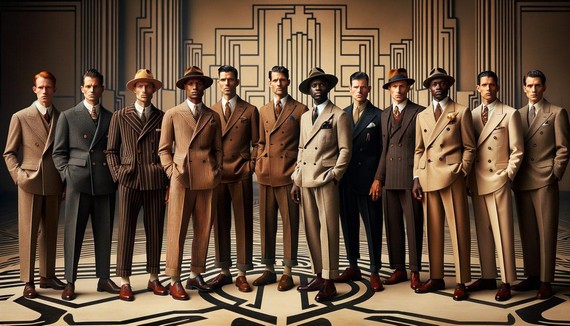
1930s mens fashion overview
Key 1930s Menswear Designers
There were several influential 1930s fashion designers shaping menswear:
- Adolphe Menjou: Known for his impeccable suits, collaborated with Valentina Schlee to bring sophistication to gentlemen’s wardrobes.
- Douglas Hayward: British 1930s Menswear designer who made his mark with sharp, clean-cut suits blending classic elegance with comfort.
- Marcel Rochas: Brought fresh vibrancy to menswear in France, crafting jackets that balanced sophistication with a hint of rebellion. His use of pinstripes nodded to tradition while embracing the avant-garde.
- Adrien Barrère: Though not a traditional designer, influenced fashion through his colorful art that popularized Parisian styles.
- Ralph Lauren: His early observations of 1930s fashion would later inform his iconic designs.
The decade also saw numerous lesser-known 1930s Menswear Designers and craftsmen contributing to the evolution of men’s style, from custom suit makers to small-town shirtmakers. Their collective efforts helped bridge practicality with artistic self-expression emplyed by 1930s fashion designers in men’s fashion.
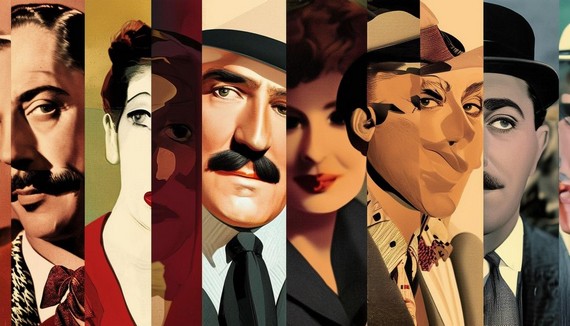
A collage of portraits featuring key 1930s fashion designers, including Adolphe Menjou, Douglas Hayward, and Marcel Rochas
1930s Menswear Designers – Impact of Economic and Social Changes
The Great Depression significantly influenced men’s fashion in the 1930s, pushing 1930s Menswear designers and consumers towards practicality and understated elegance. Suits became more streamlined, focusing on durability and functionality without sacrificing style. This shift introduced a kind of “quiet luxury,” where the cut took precedence over embellishments.
Social changes brought a more democratic influence to fashion. The rigid class-based clothing distinctions began to blur, with high society embracing middle-class practicality and everyday men incorporating touches of flair into their wardrobes.
Hollywood played a crucial role in shaping men’s fashion during this time. Stars like Clark Gable and Gary Cooper showcased a blend of aspirational and accessible style, inspiring men to achieve sophistication through practical pieces and clever pairing.
“The collection embodies gold standard lightweight tailoring and typewriter fabric, championing the timeless elegance and poignant nostalgia of this bygone era.”
1930s fashion designers responded to economic constraints by innovating with textiles. Fabrics like rayon emerged as affordable alternatives to silk or wool, allowing men to maintain a dignified appearance even on a budget. This era of pragmatic style taught a valuable lesson in finding elegance within constraints, a principle that continues to influence fashion today.
Evolution of Menswear Silhouettes
The 1930s saw a significant shift used by 1930s fashion designers in menswear silhouettes, characterized by broader shoulders, high waists, and wide-leg trousers. This transformation reflected both aesthetic preferences and societal changes of the era.
- Broader shoulders, often enhanced with pads, conveyed an air of strength and confidence.
- High-waisted trousers created an elongating effect, offering a psychological boost during challenging times.
- Wide-leg trousers provided comfort and adhered to the decade’s emphasis on practicality, often featuring pleats and turn-ups for added sophistication.
These new silhouettes used by 1930s Menswear Designers represented more than just changing styles; they embodied a cultural narrative of resilience and self-assurance. The interplay of these elements balanced tradition with modernity, allowing for individual expression within the constraints of the era.
Fabrics and colors played a crucial role in completing the look. Rich earth tones, navy, and charcoal were popular choices, while varying textures added depth to ensembles. This evolution in menswear silhouettes ultimately told a story of adapting to economic challenges while maintaining a sense of style and hope for the future.
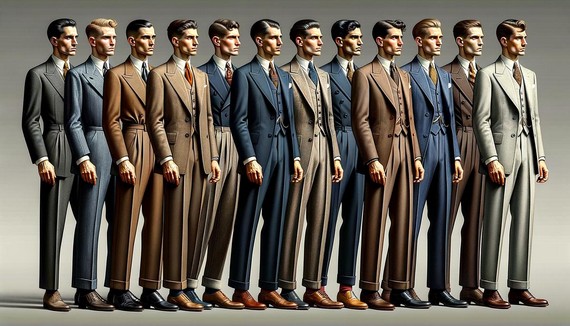
A lineup of men showcasing the evolution of 1930s menswear silhouettes, from broader shoulders to high-waisted trousers
1930s Menswear Designers – Influence of Hollywood and Celebrities
Hollywood 1930s fashion designers were a major influence on men’s fashion, beaming images of glamour and sophistication into cinemas worldwide. The stars’ wardrobes became a source of inspiration for men looking to elevate their style.
- Clark Gable: His fitted suits and bold choices, like going without an undershirt in “It Happened One Night,” set new trends.
- Fred Astaire: His debonair ensembles, complete with top hats and tails, showcased timeless refinement with a modern twist.
- Cary Grant: His polished practicality, particularly his preference for double-breasted suits and crisp shirts, resonated with audiences seeking everyday elegance.
Directors and 1930s Menswear costume Designers worked together to create wardrobes that not only suited characters but also reflected and anticipated changing societal ideals. This cinematic fashion influence extended beyond American borders, inspiring a transatlantic exchange of styles.
Hollywood’s 1930s Menswear Designer’s impact on men’s fashion during this era was profound, offering a template for modern dressing that blended fantasy and reality. It provided men with accessible examples of elegance and style, allowing them to incorporate elements of silver screen glamour into their everyday lives.
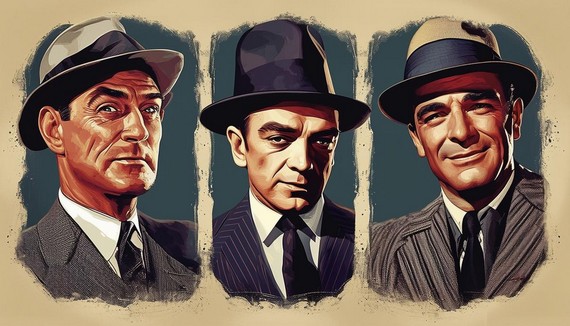
A composite image of Clark Gable, Fred Astaire, and Cary Grant in their iconic 1930s outfits, influencing men’s fashion
1930s Fashion Designers – Materials and Fabrics of the Era
1930s Menswear fashion designers in the 1930s showcased a blend of traditional and innovative materials, reflecting the era’s economic challenges and technological advancements. Wool, cotton, and tweed remained popular, while synthetic fabrics emerged as affordable alternatives.
Wool suits continued to symbolize luxury and practicality. Its breathability and insulating properties made it ideal for year-round wear. Lightweight variations like flannel offered comfort without sacrificing elegance.
Cotton was expanded by 1930s Menswear Designers beyond shirts into casual wear. The rise of separates allowed men to mix and match, stretching their wardrobes further. Cotton jackets paired with different trousers embodied a relaxed formality.
Tweed represented British refinement and durability. Its coarse texture aligned with the decade’s utilitarian spirit, suitable for both countryside activities and urban settings.
Synthetic fabrics like rayon and acetate emerged as cost-effective options. Often called ‘artificial silk,’ rayon provided an affordable alternative with a luxurious feel. These synthetics were used in shirts, neckties, and even suit linings, offering practicality and a touch of elegance.
While early synthetics sometimes lacked longevity, they laid the groundwork for future innovations by 1930s Menswear Designers. They allowed men to maintain a sophisticated appearance without excessive spending, aligning with the era’s egalitarian trends.
The materials that 1930s fashion designers used reflected a balance between tradition and innovation, demonstrating how 1930s Menswear Designers adapte fashion to societal changes. From everyday wear to Hollywood glamour, these fabrics clothed diverse lifestyles, leaving a lasting impact on menswear.
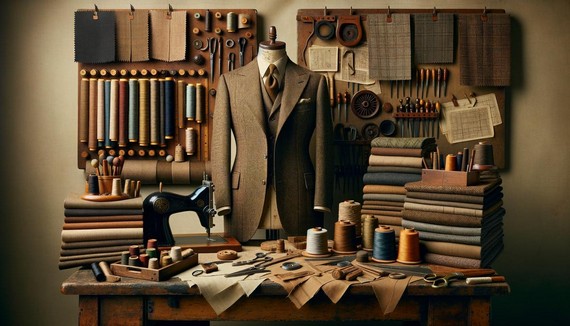
A display of various 1930s men’s fashion materials, including wool, cotton, tweed, and synthetic fabrics
The enduring legacy of fashion by 1930s menswear designers lies in its ability to marry resilience with refinement, crafting a style that speaks to both the challenges and aspirations of its time. This blend of practicality and elegance continues to inspire, reminding us of the power that 1930s fashion designers created that continues to to adapt and endure.
Related posts:


